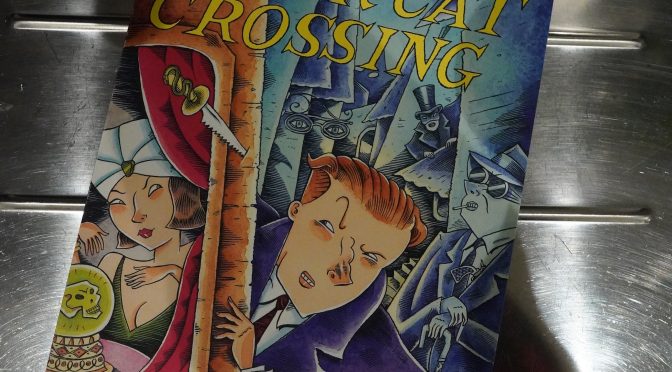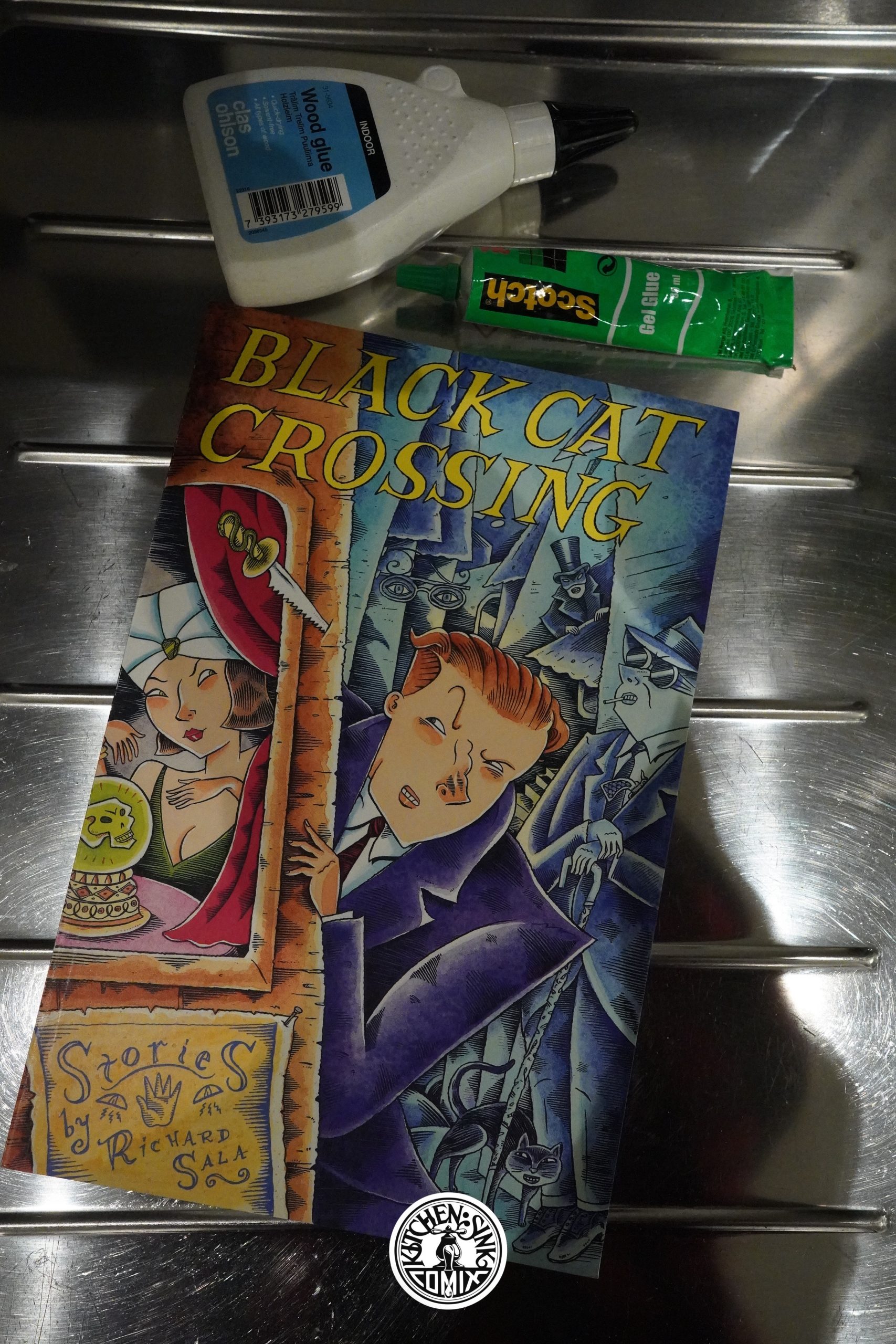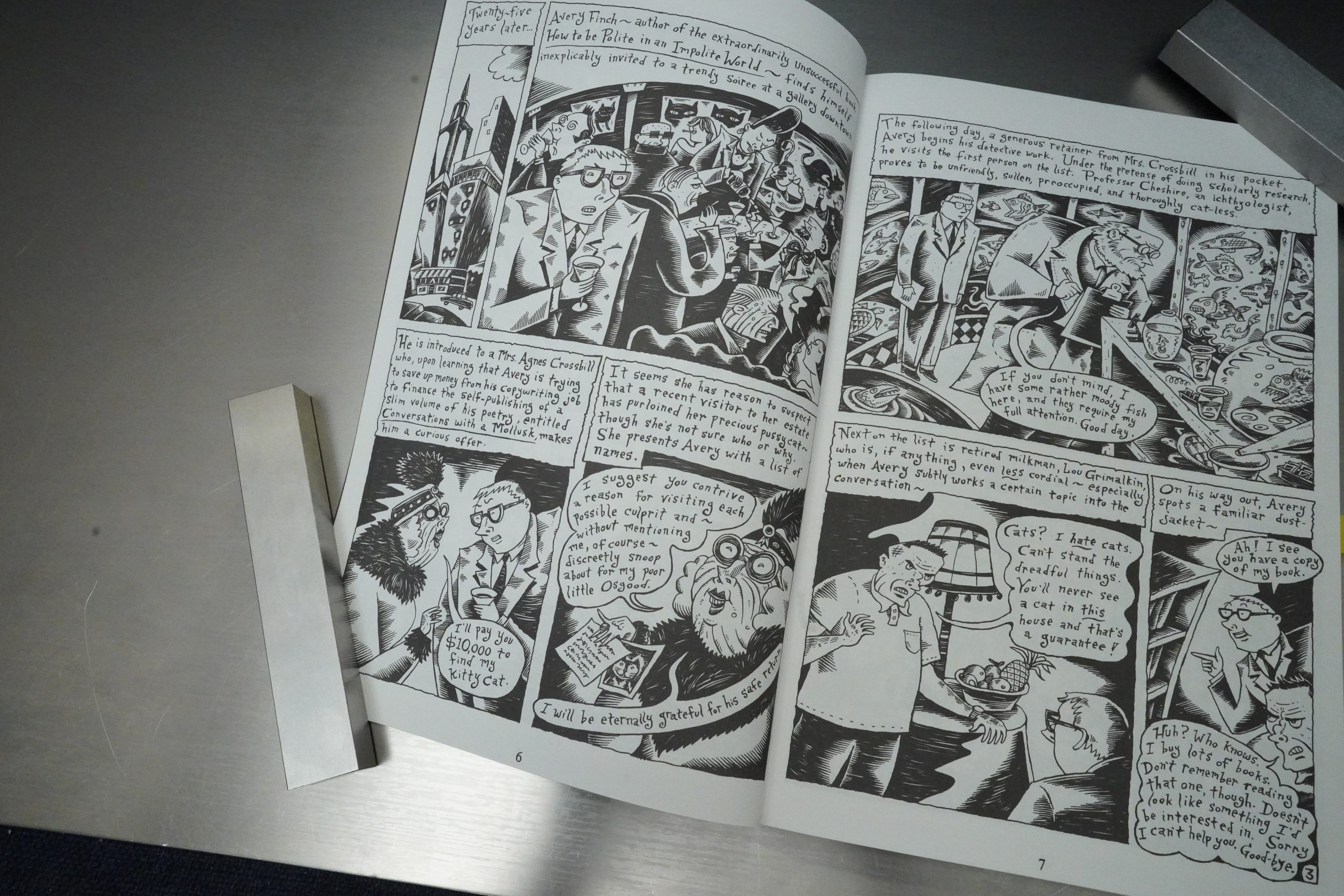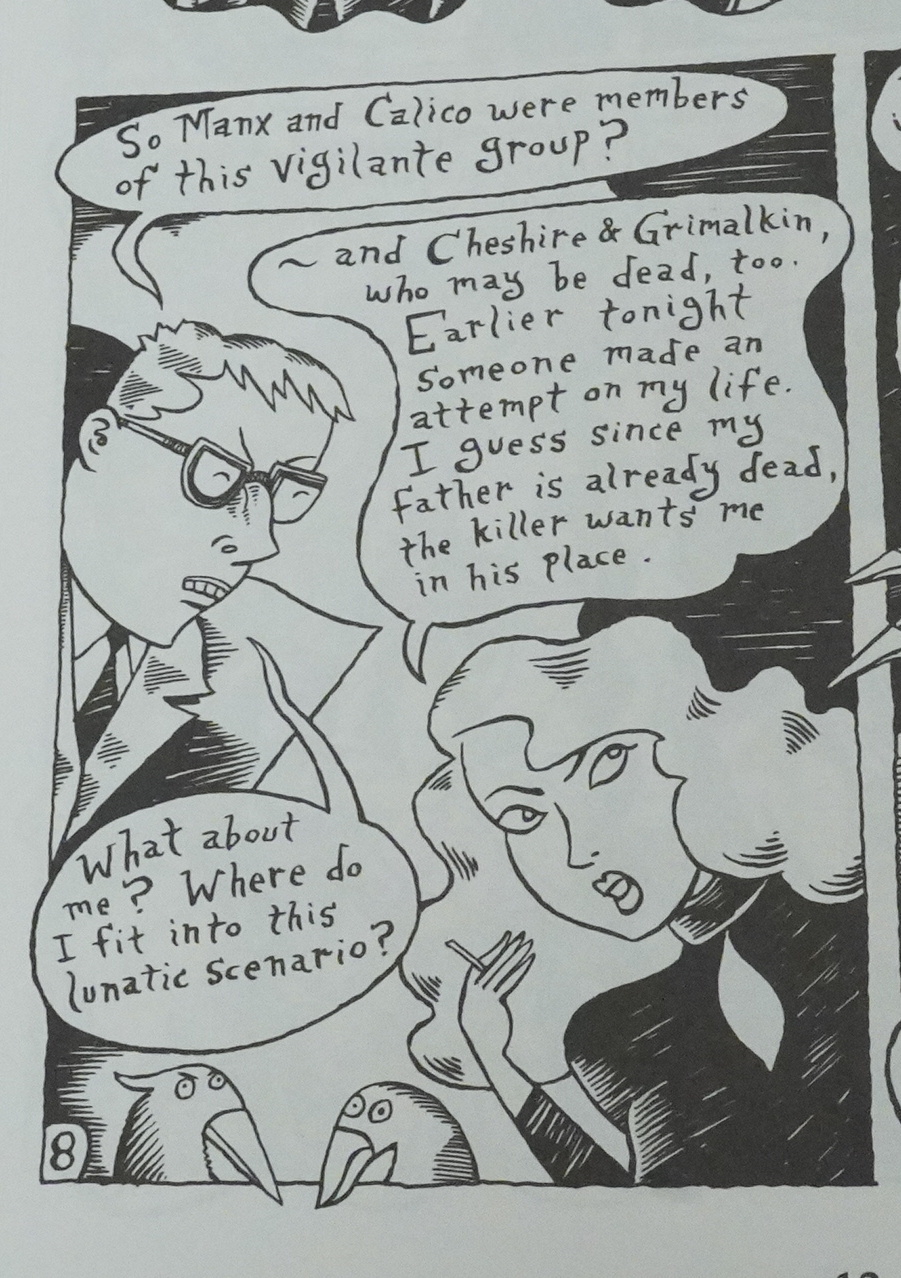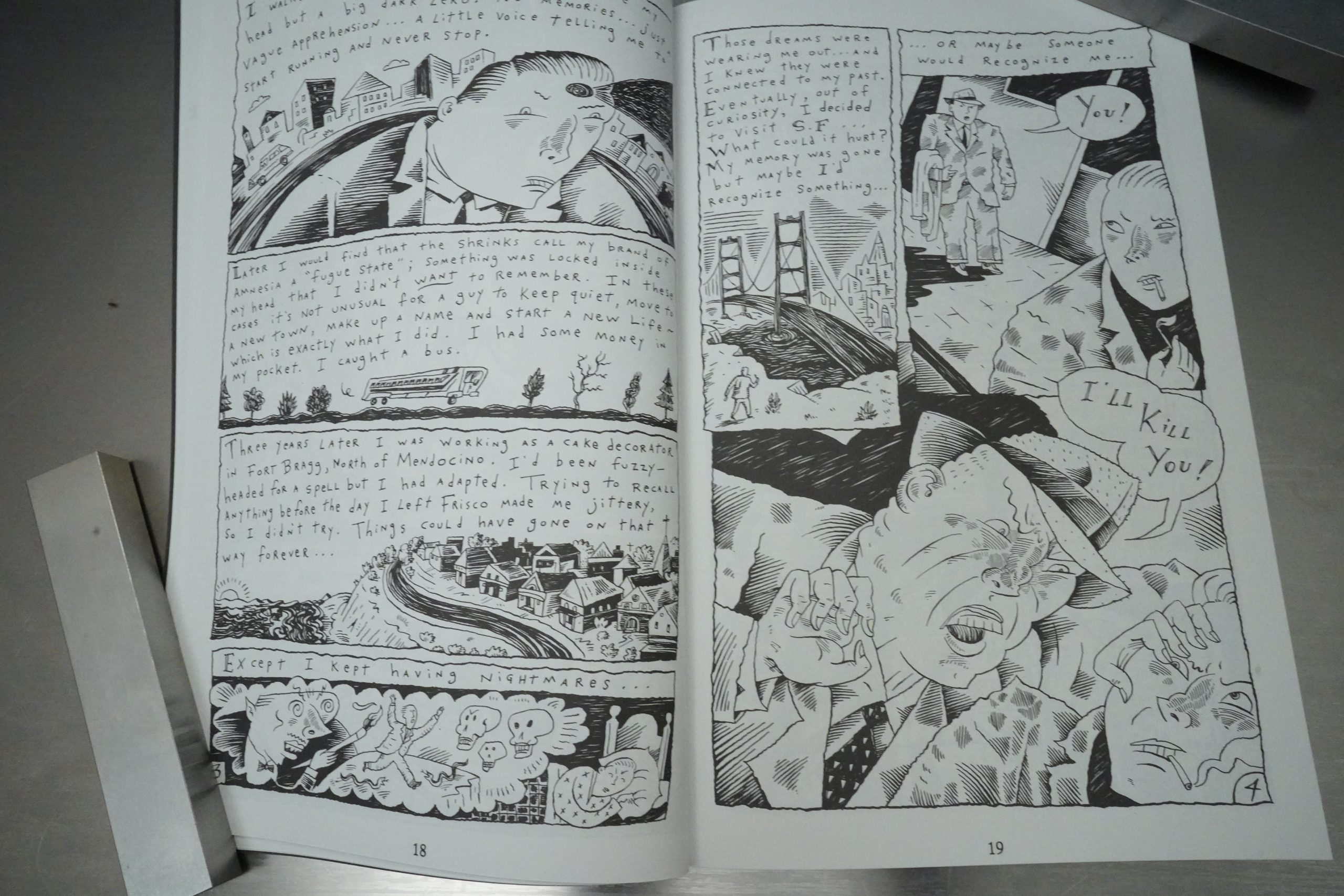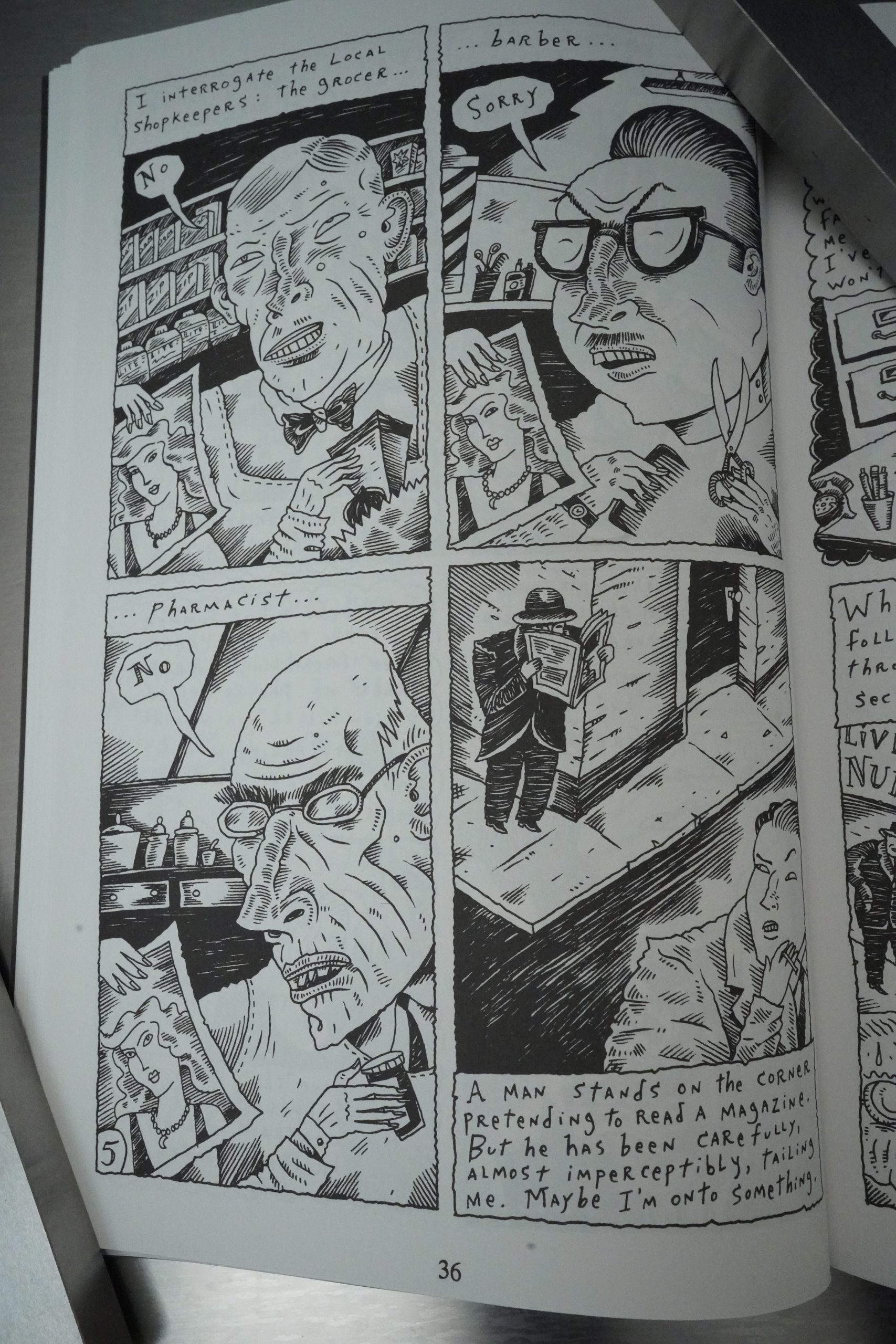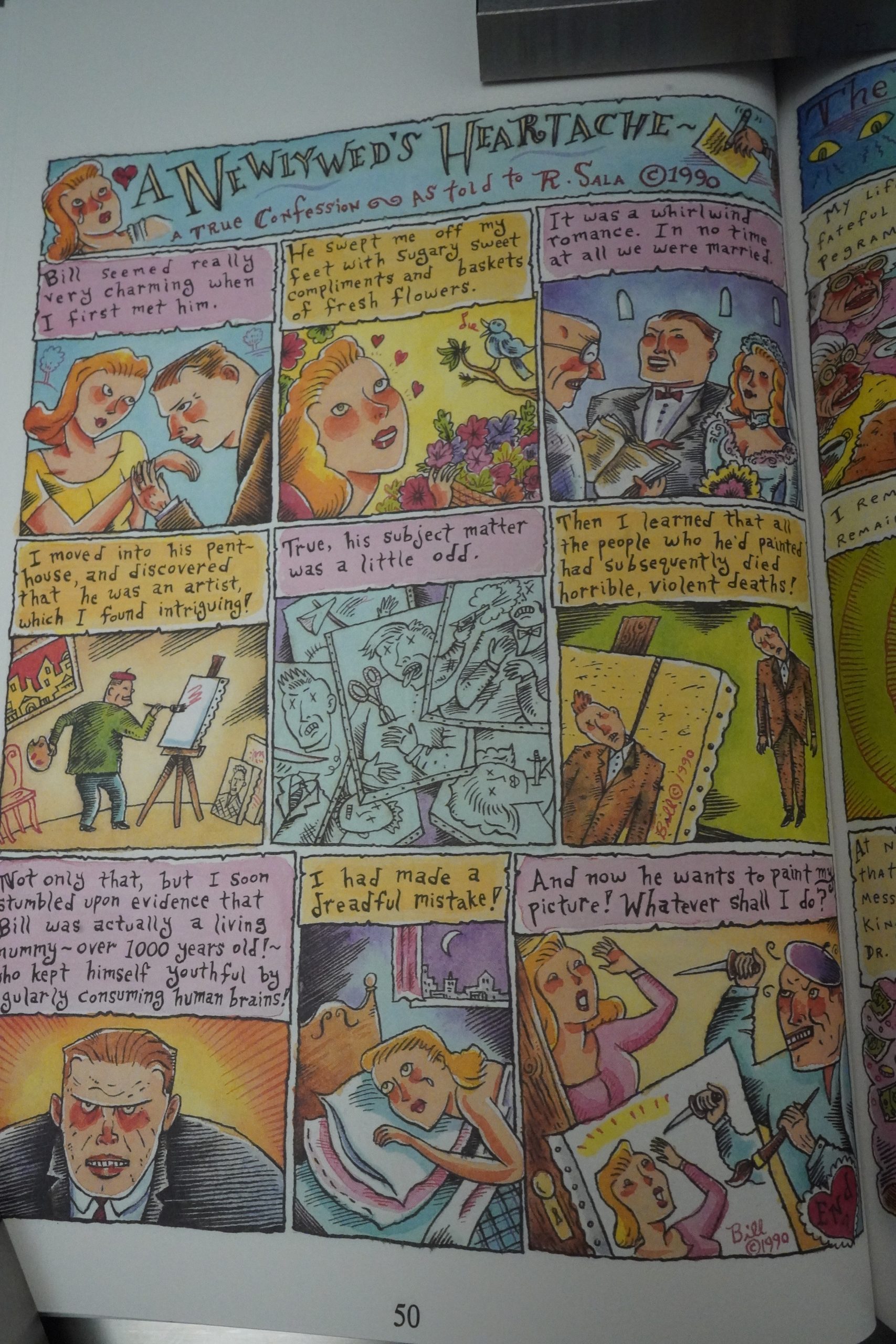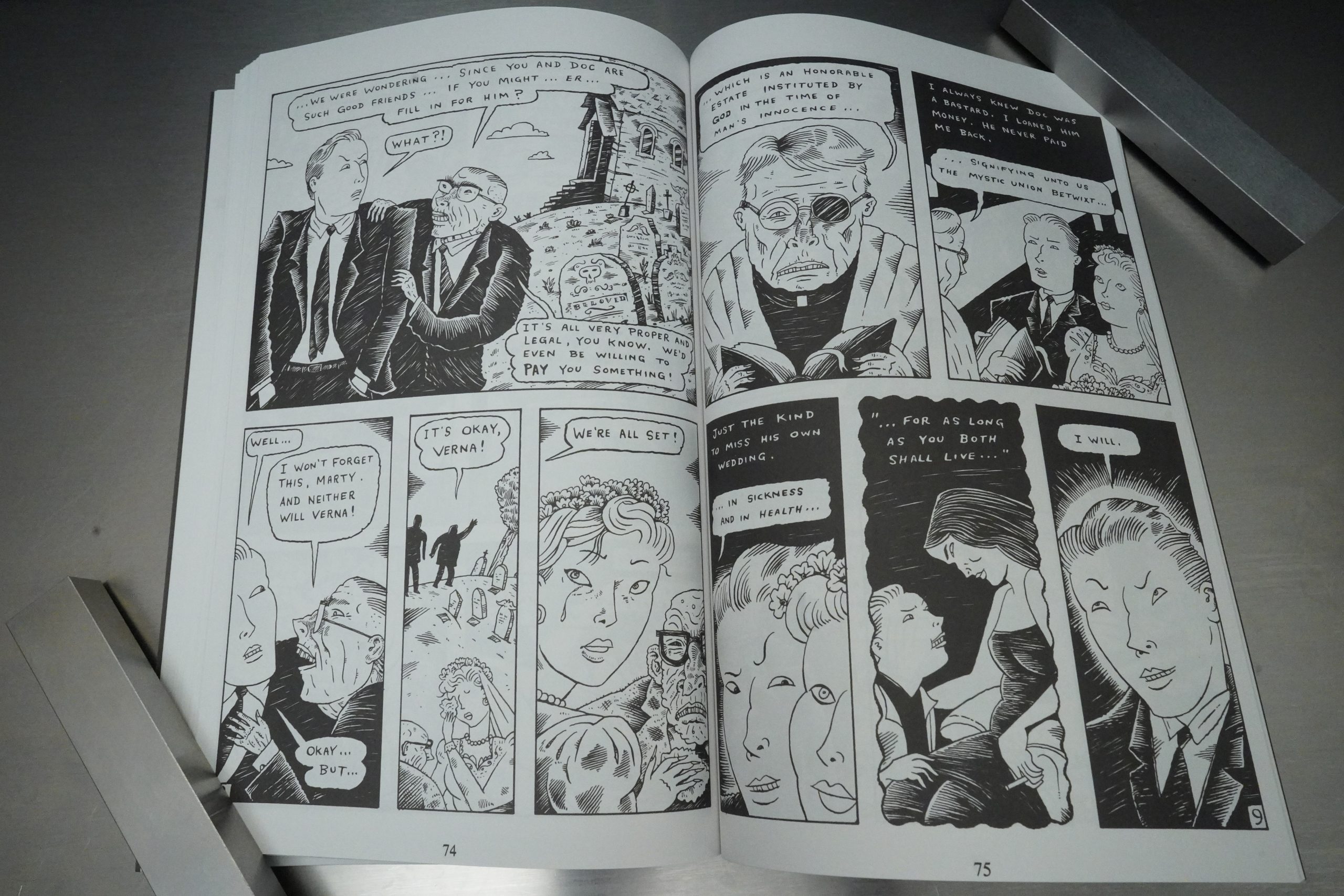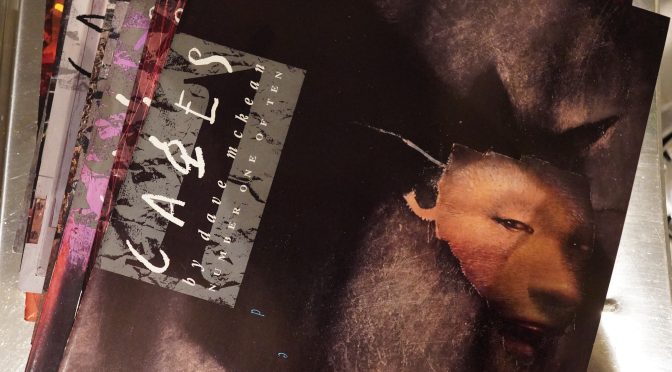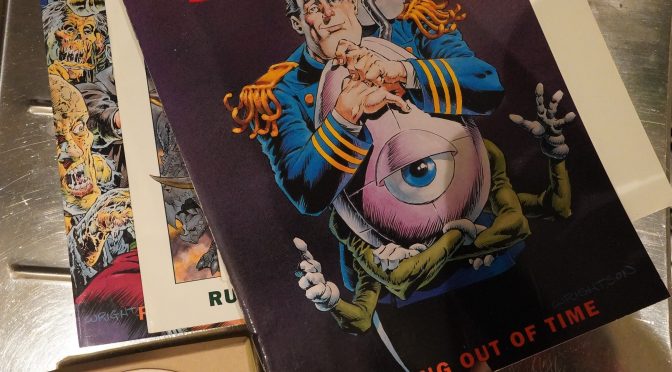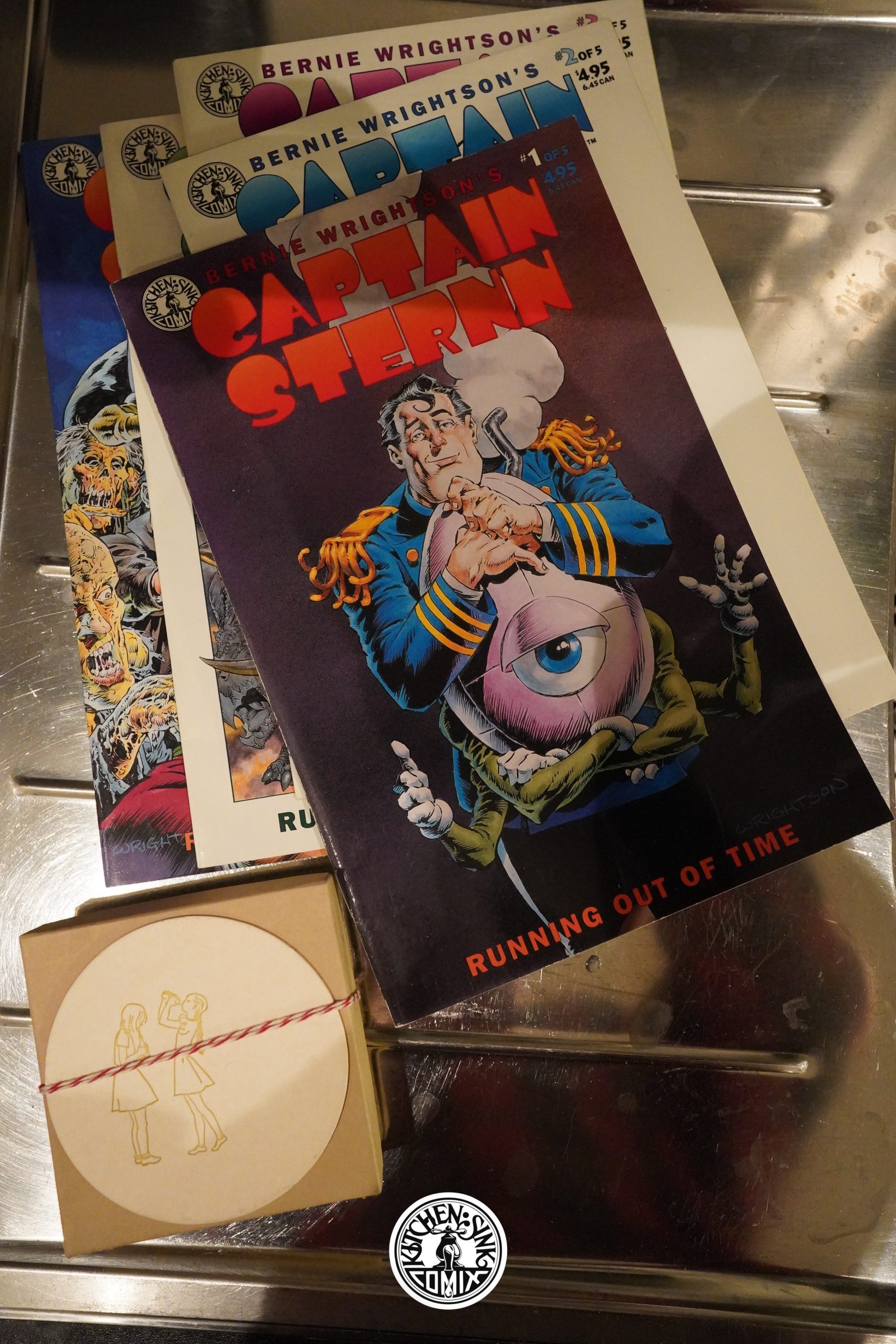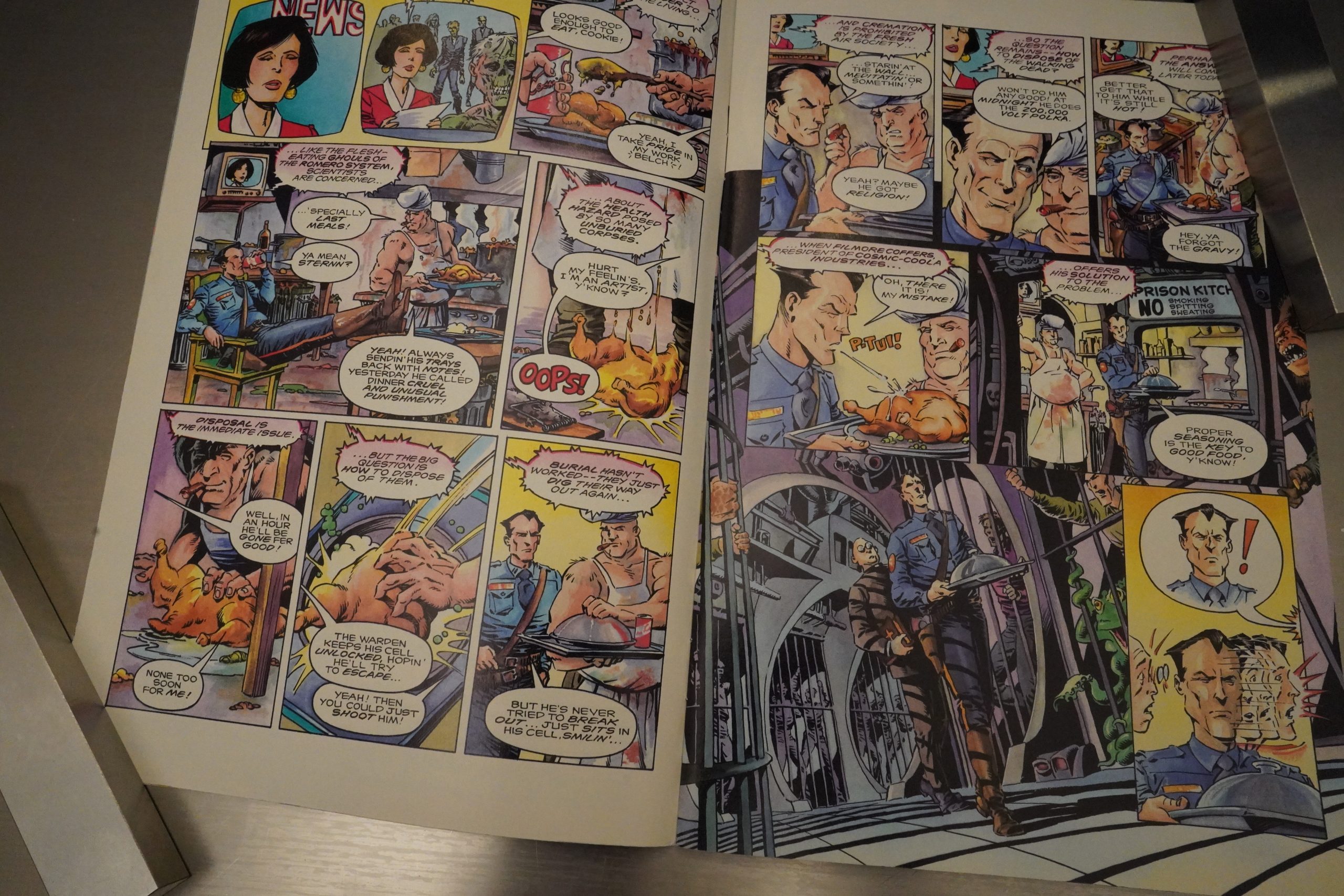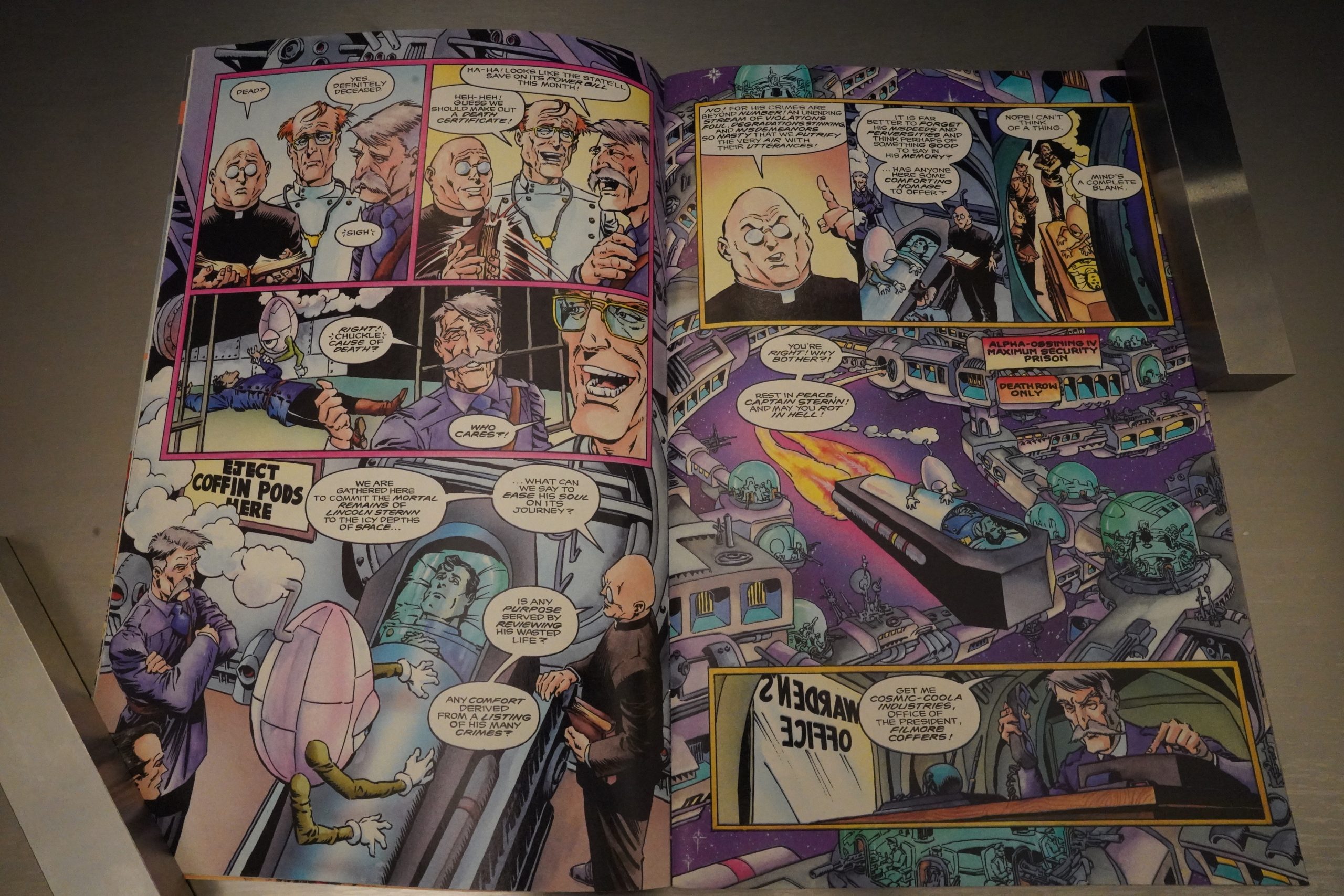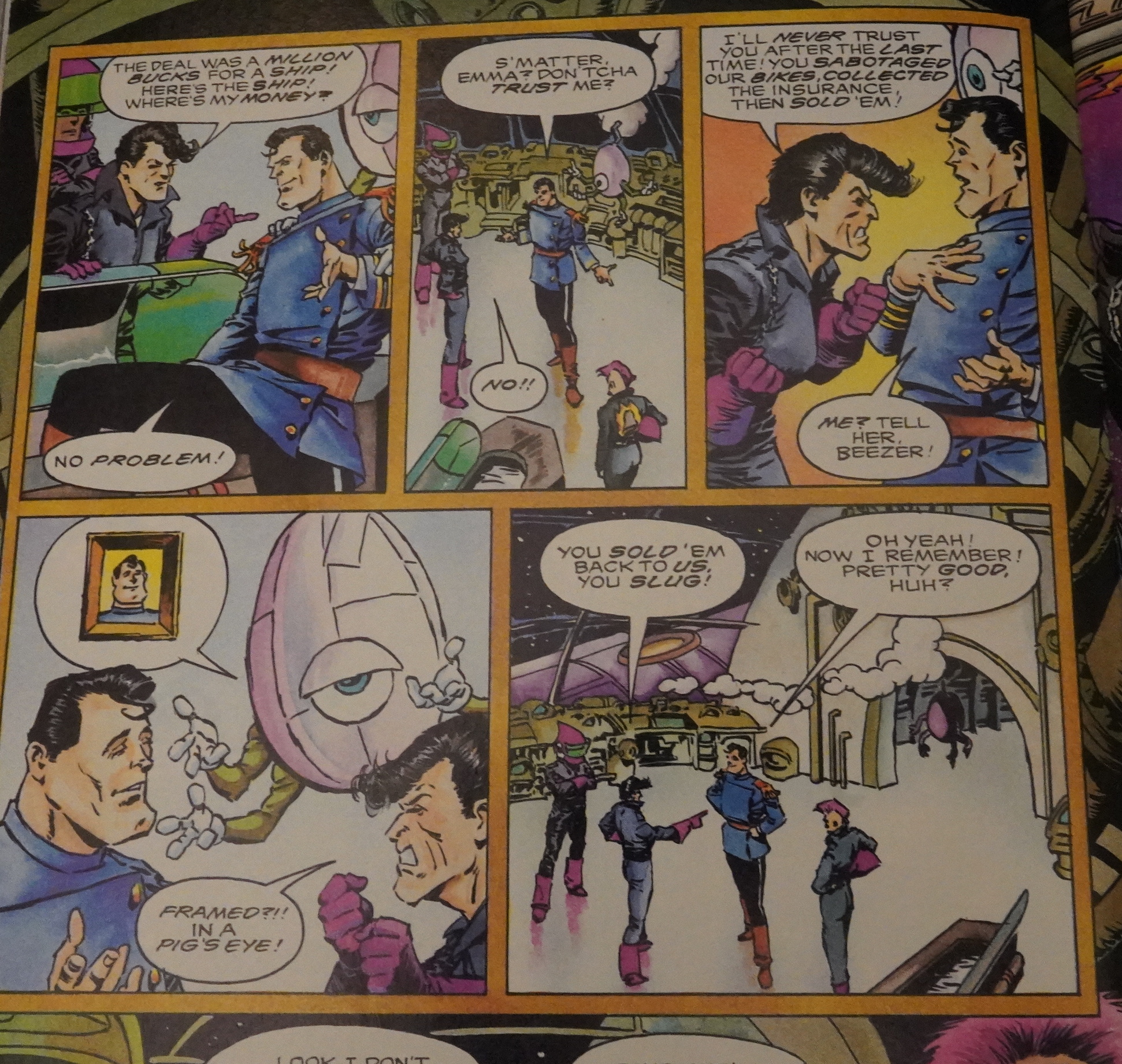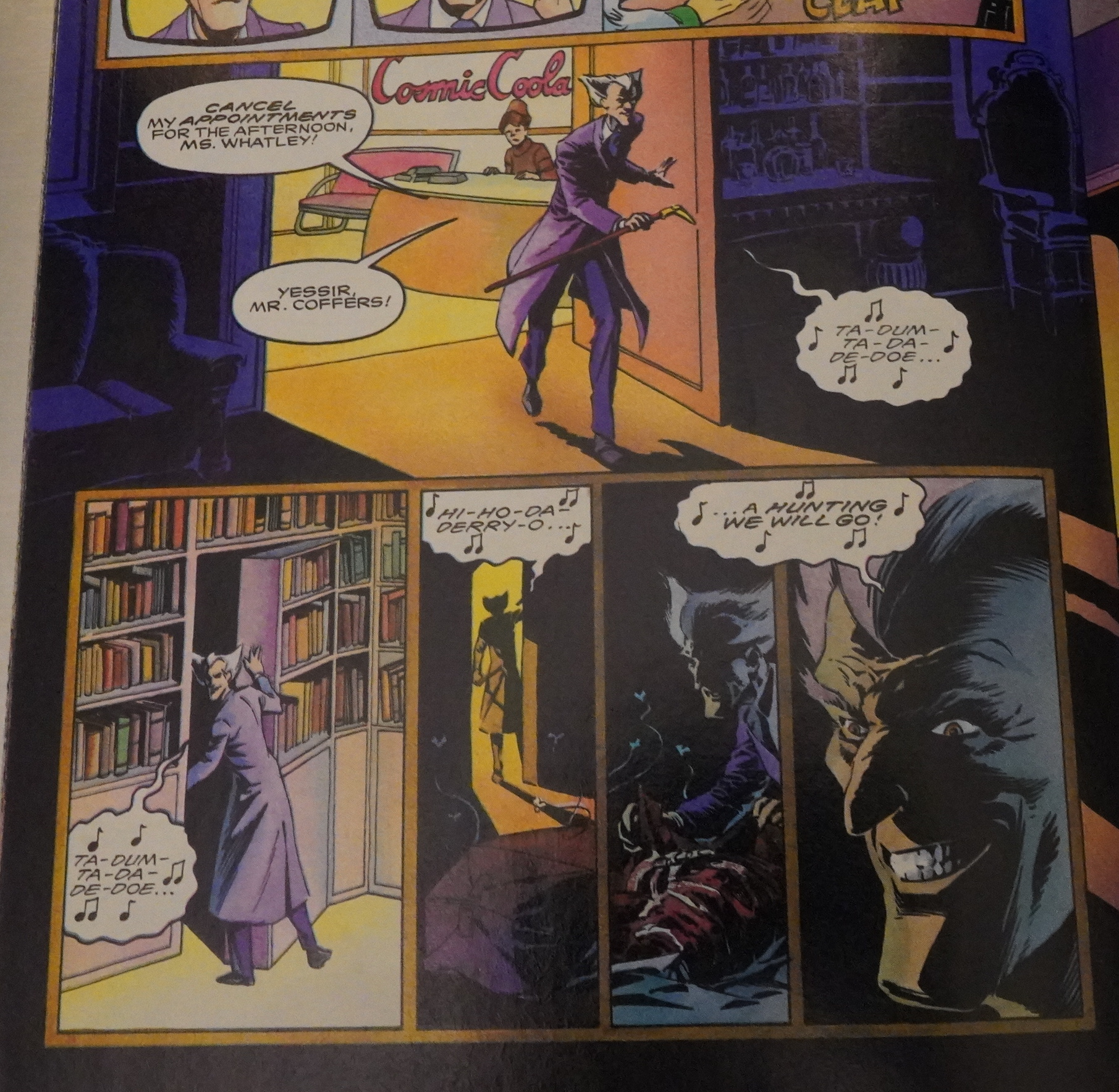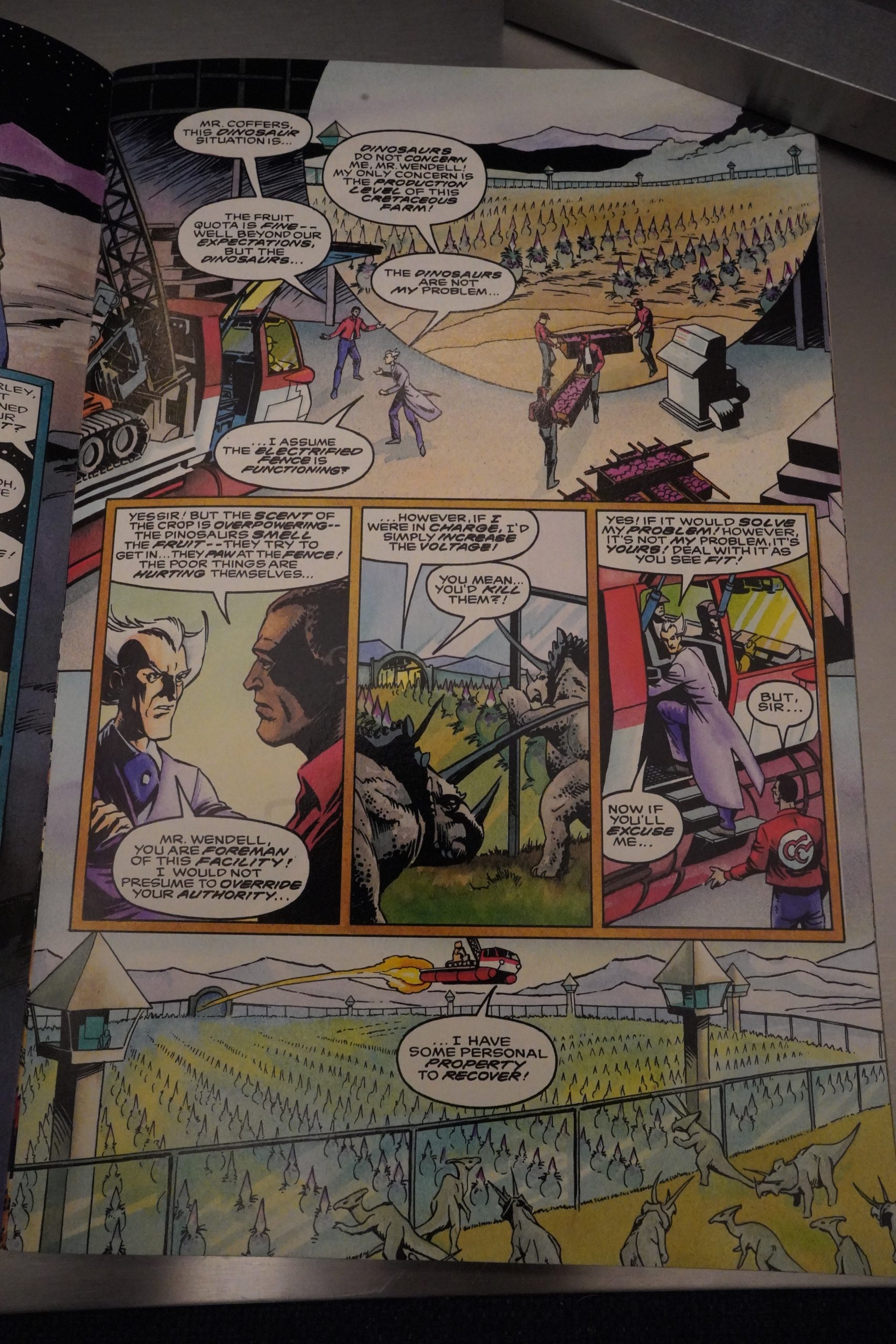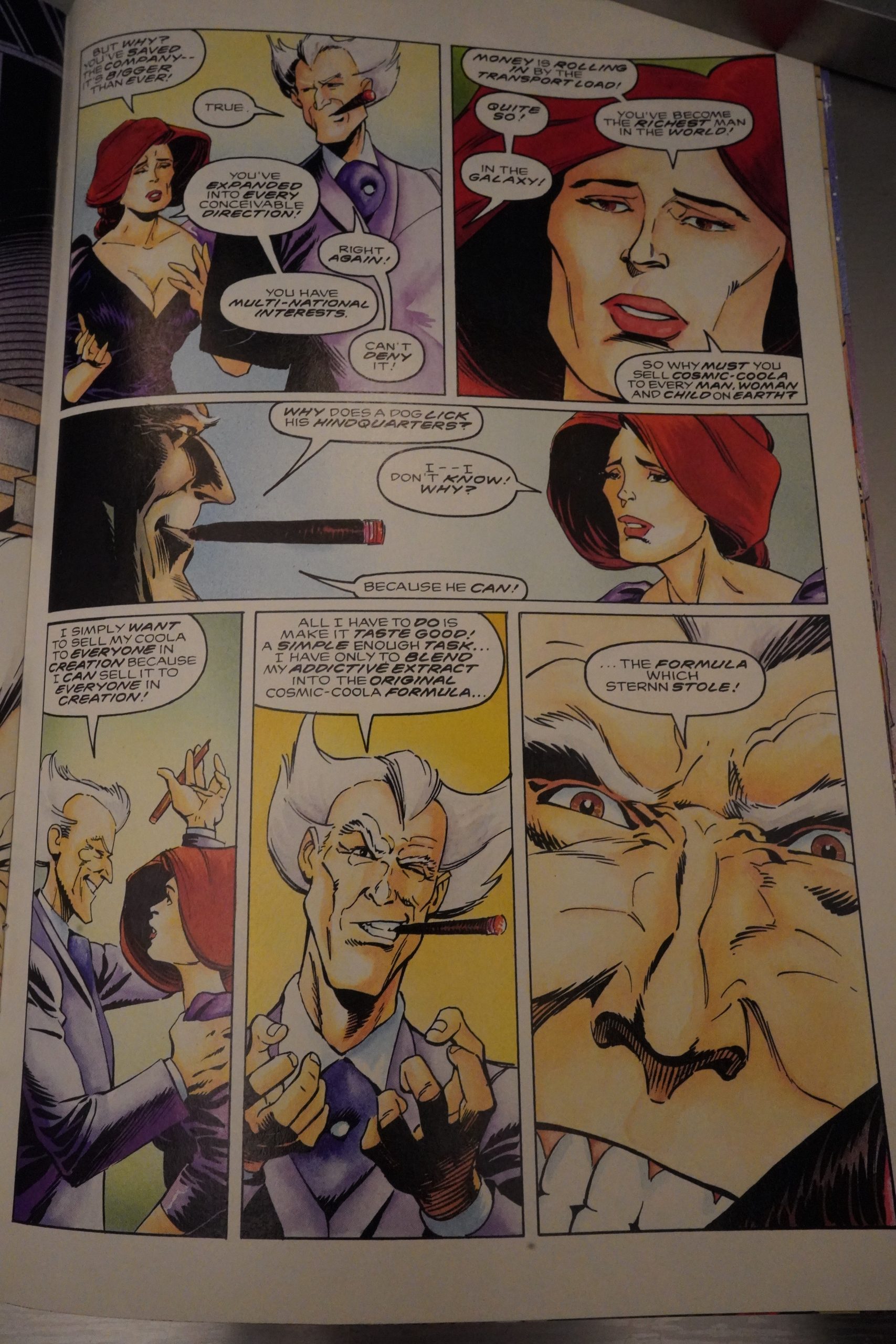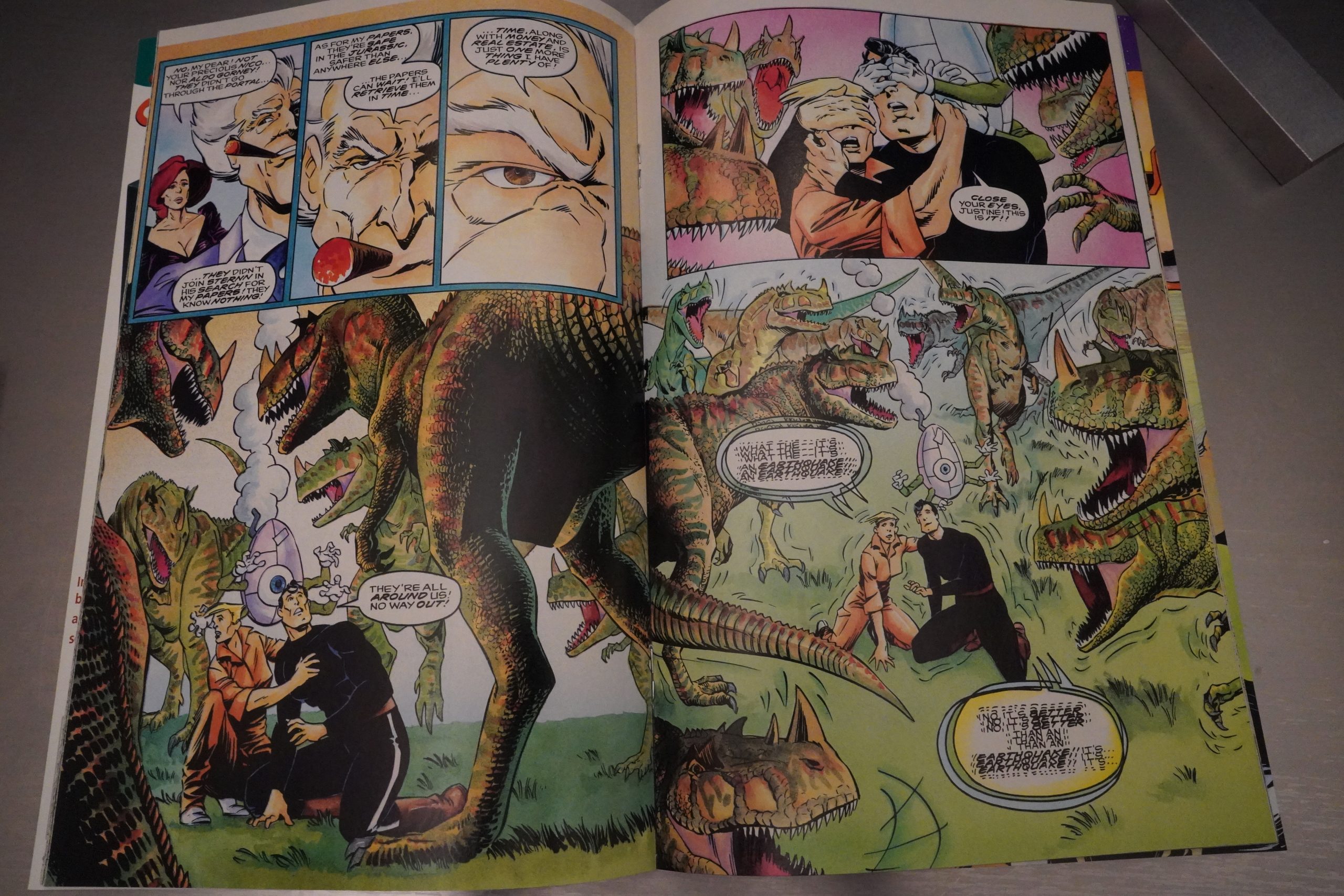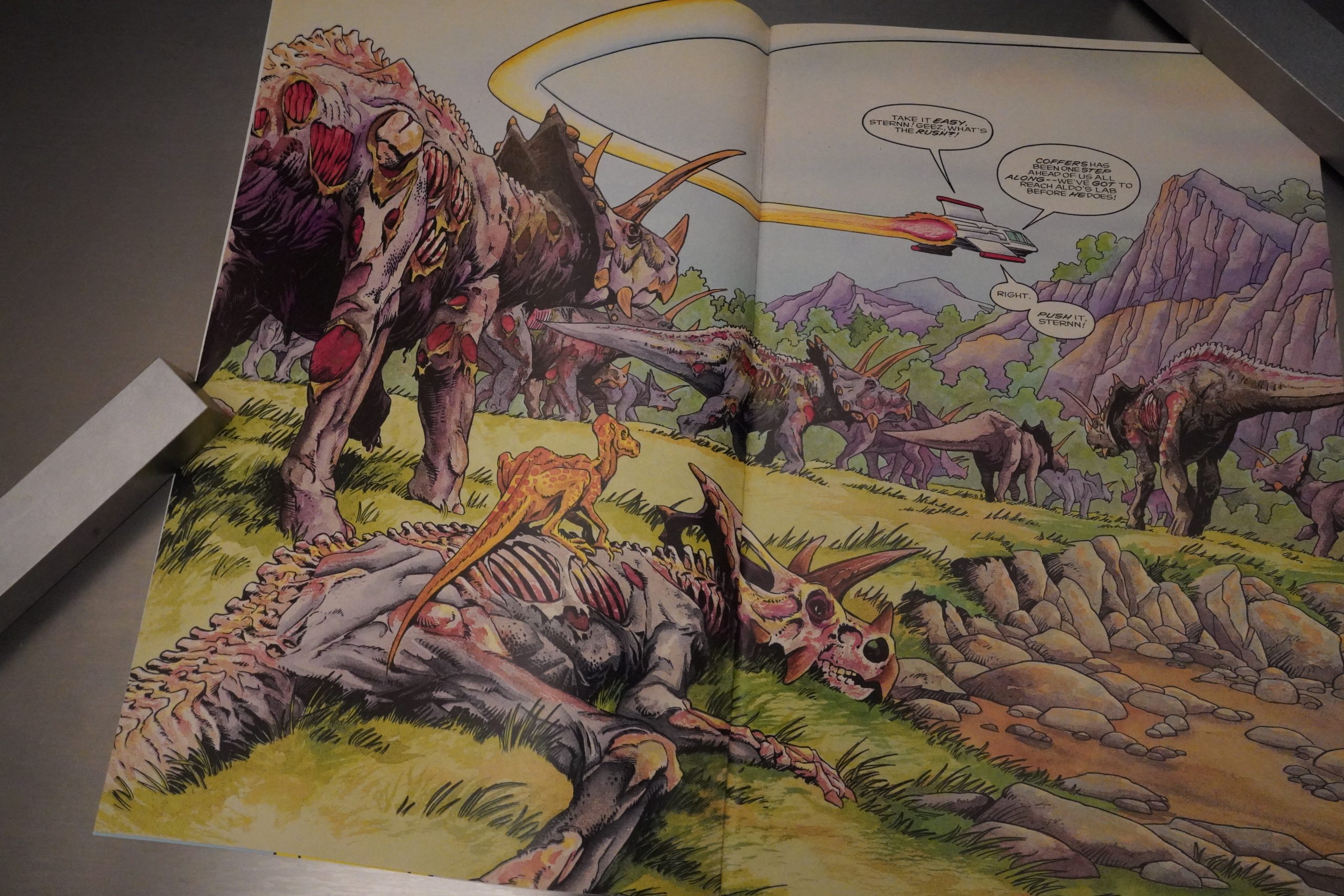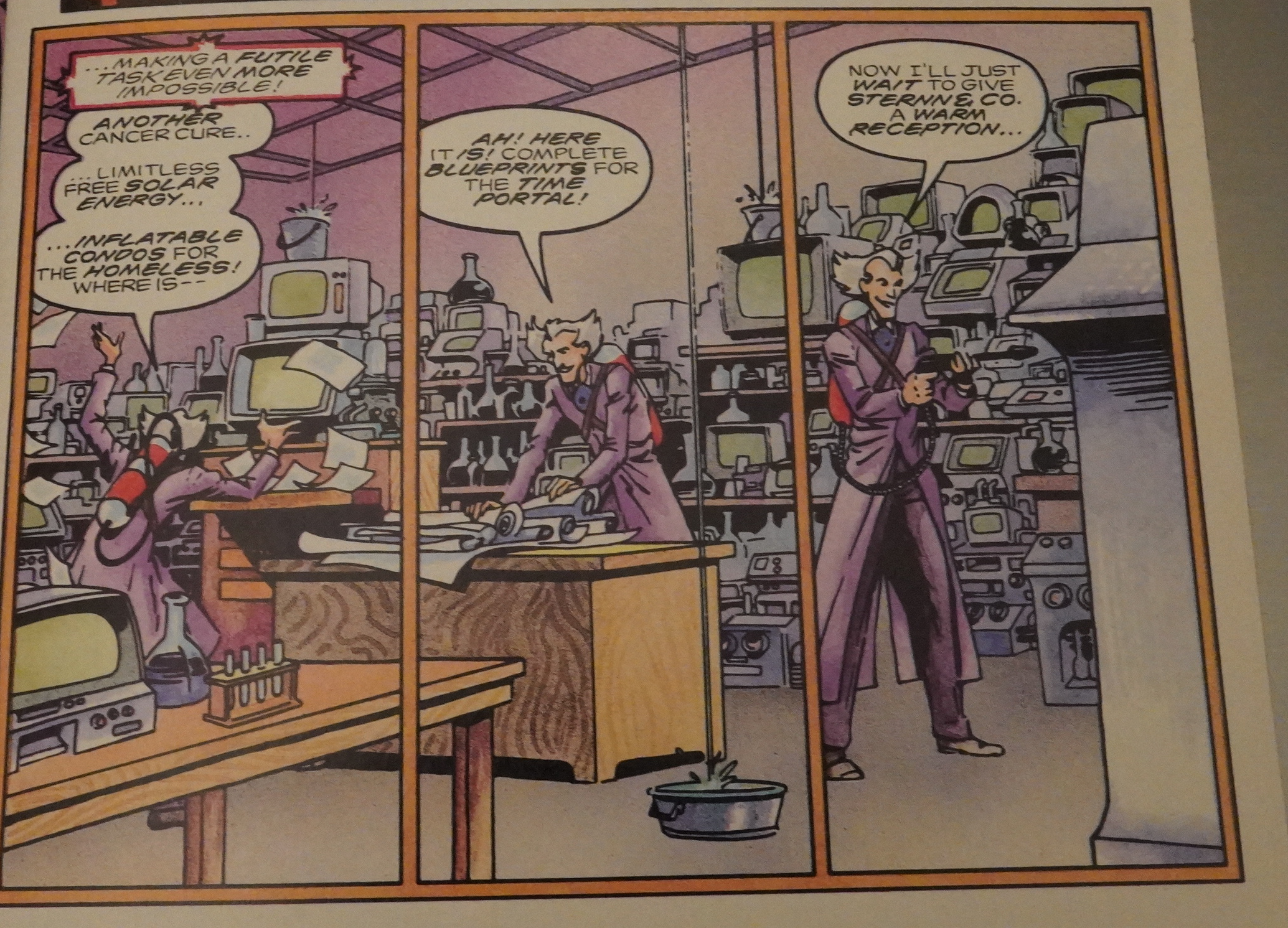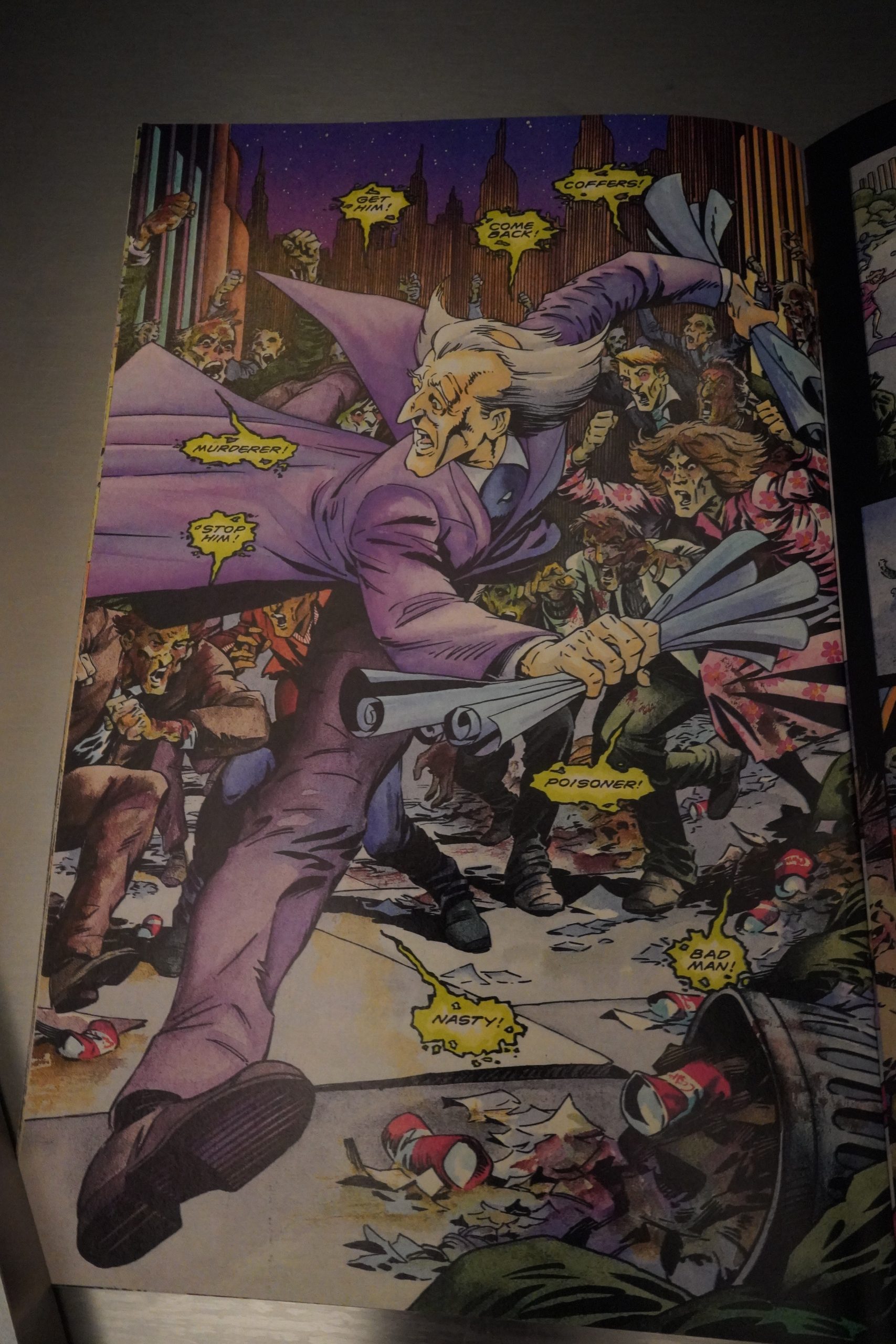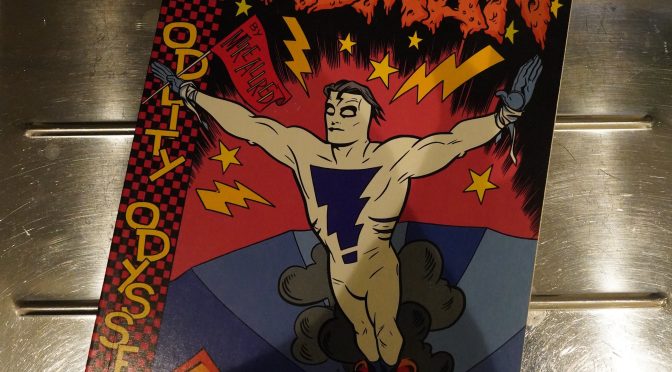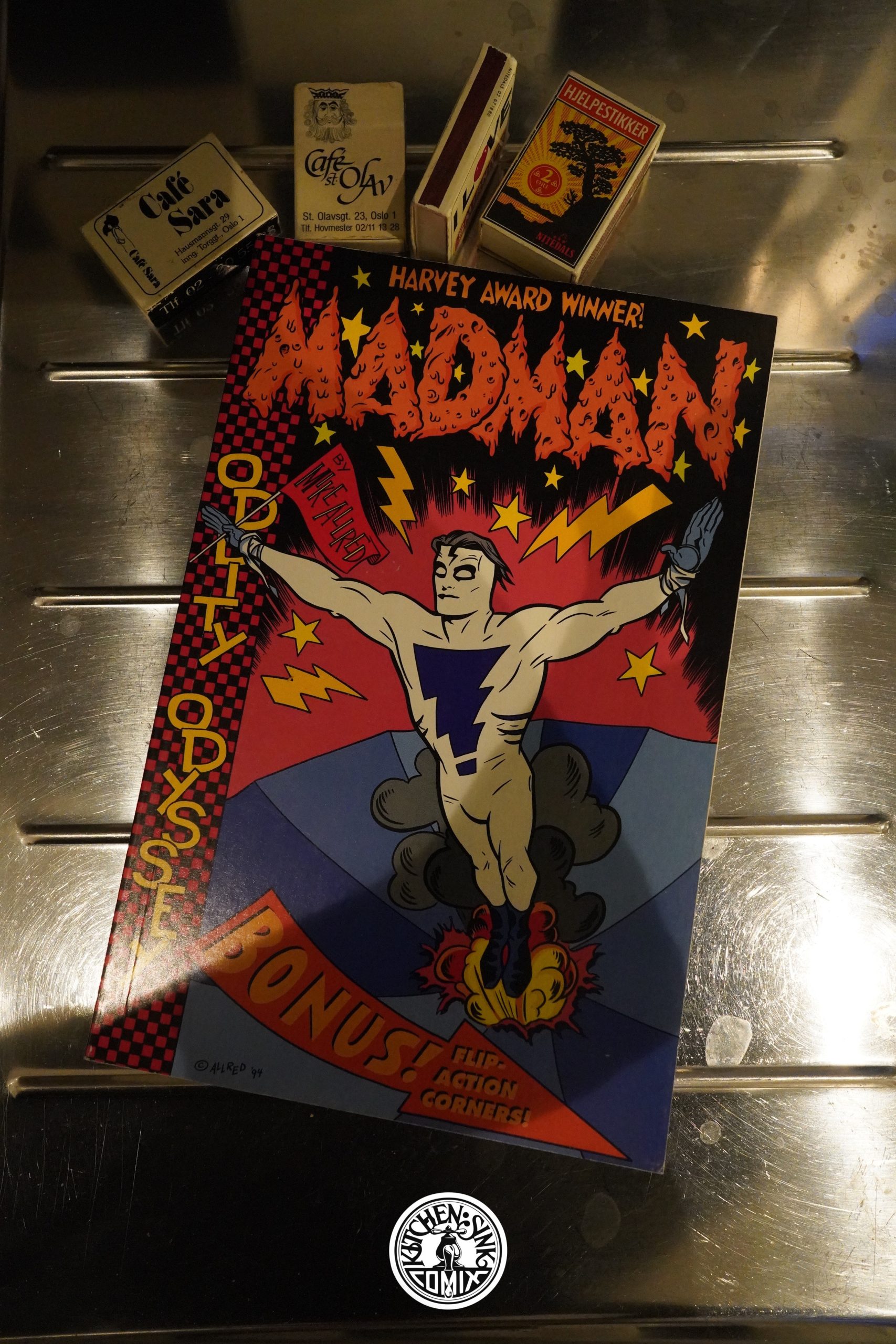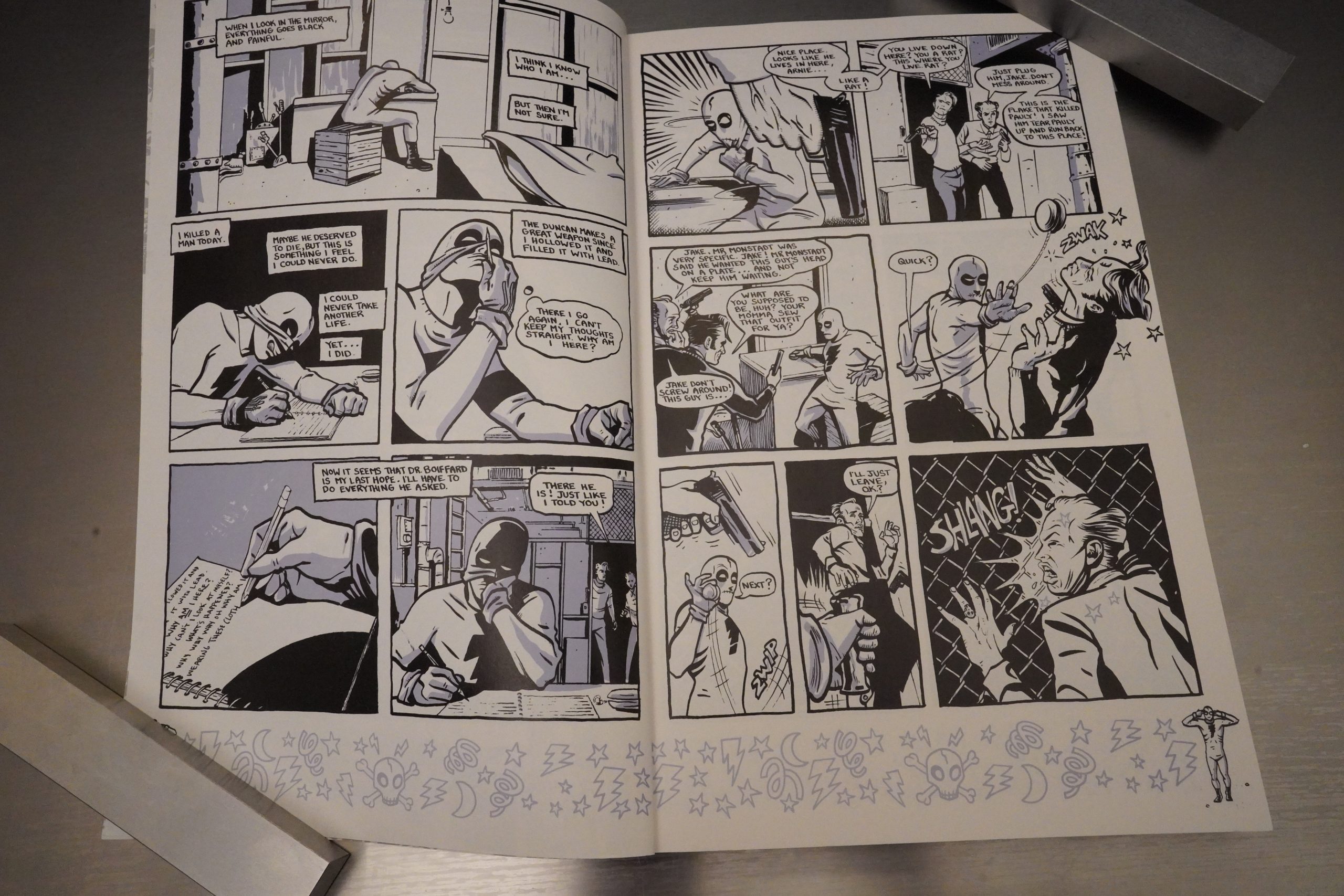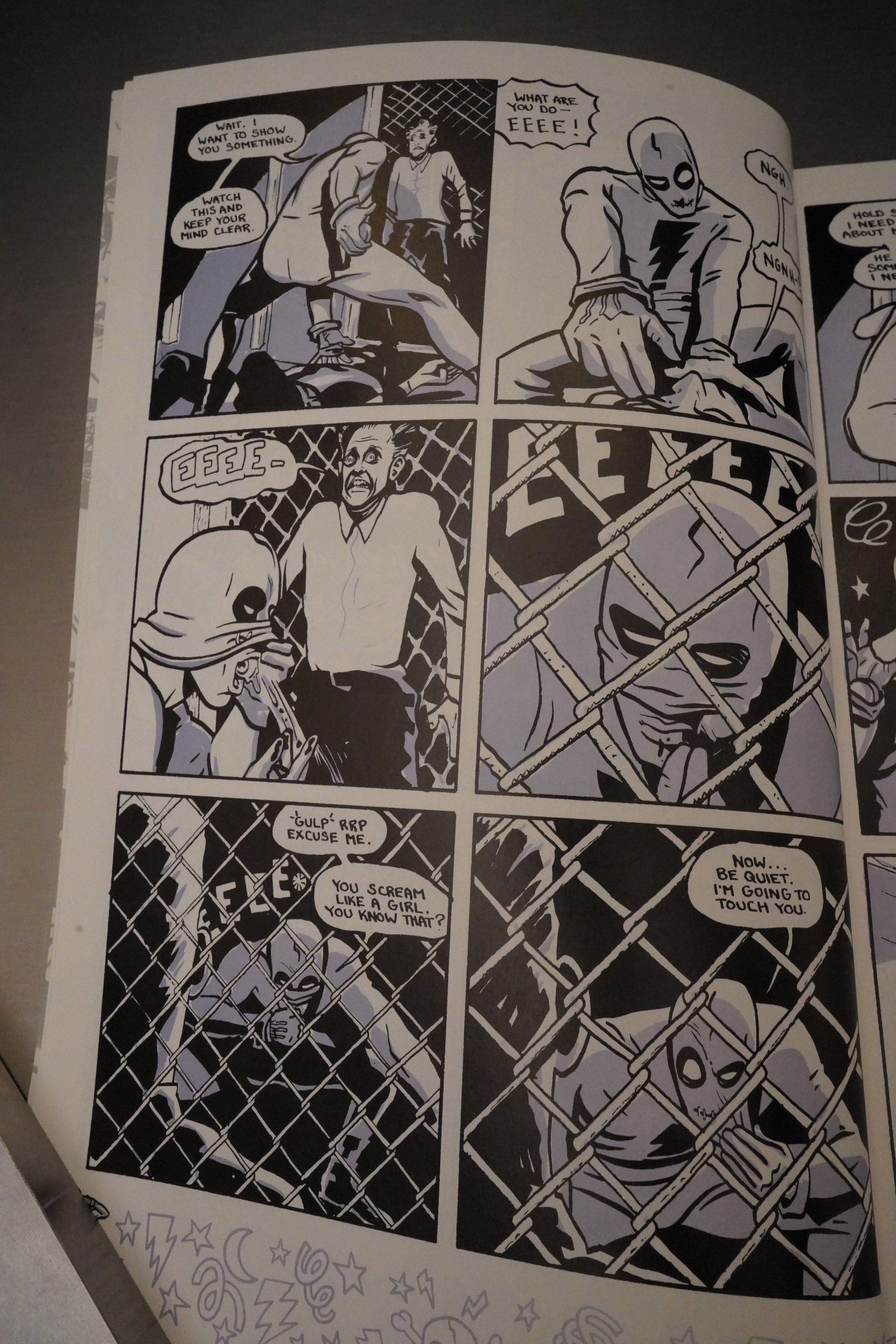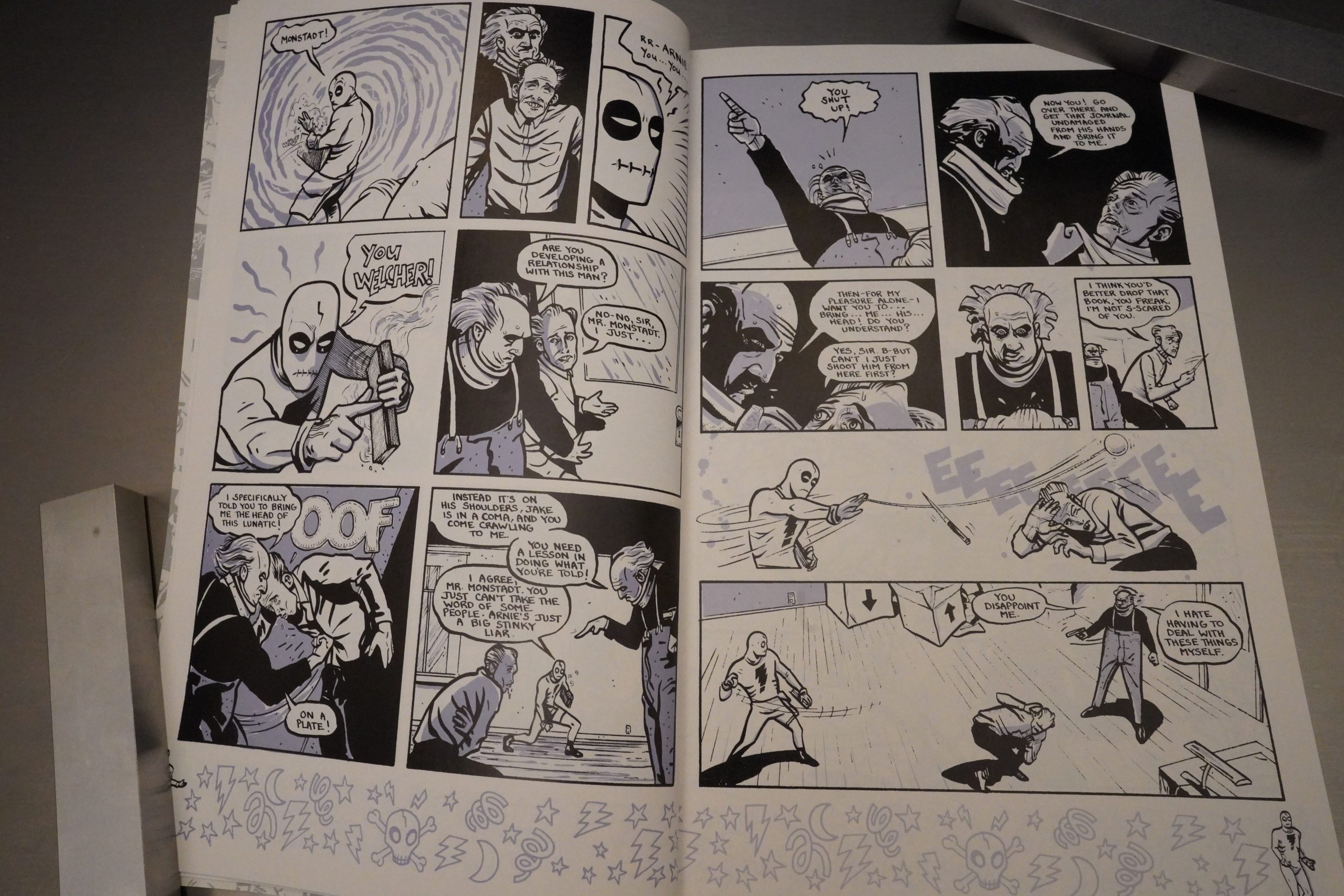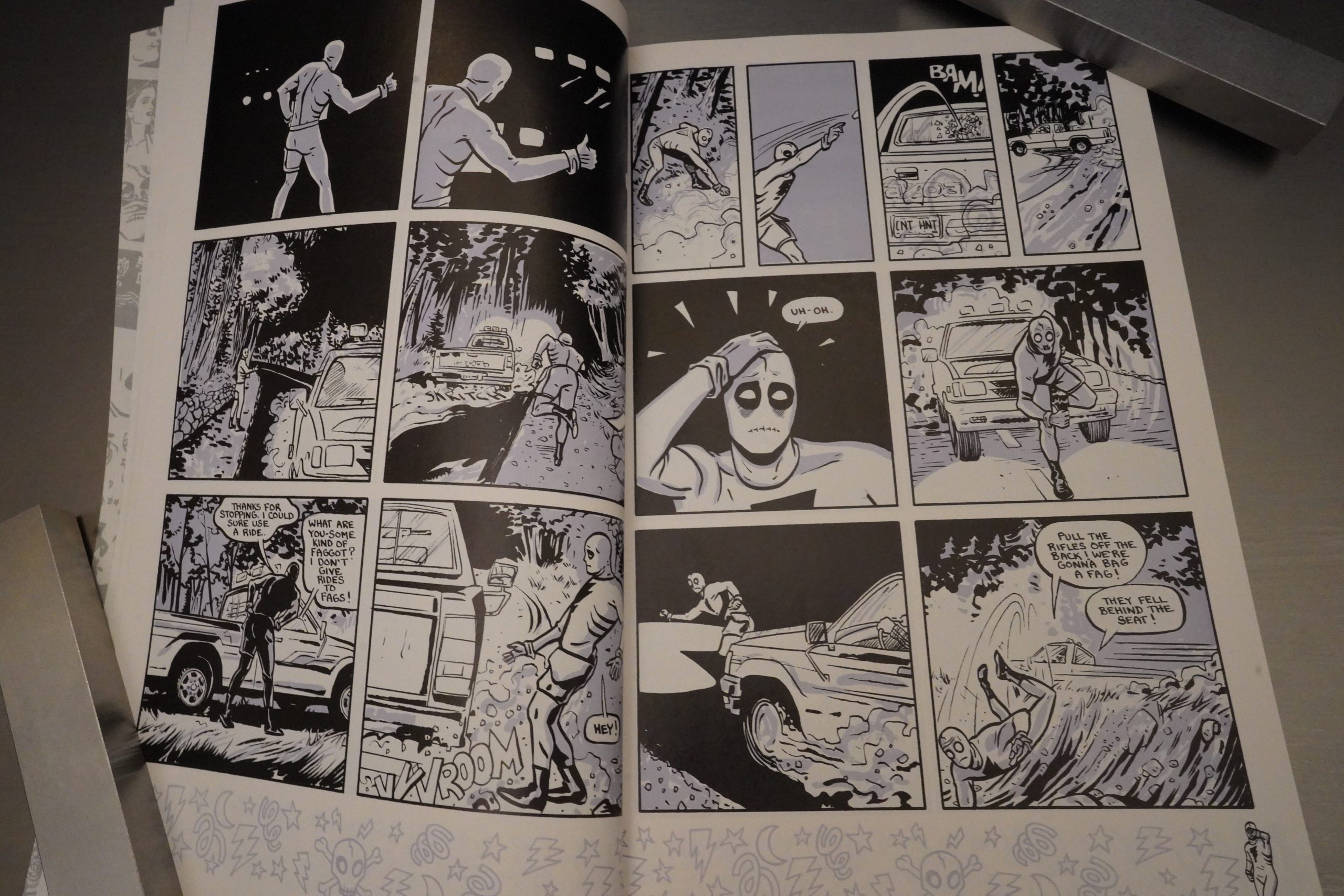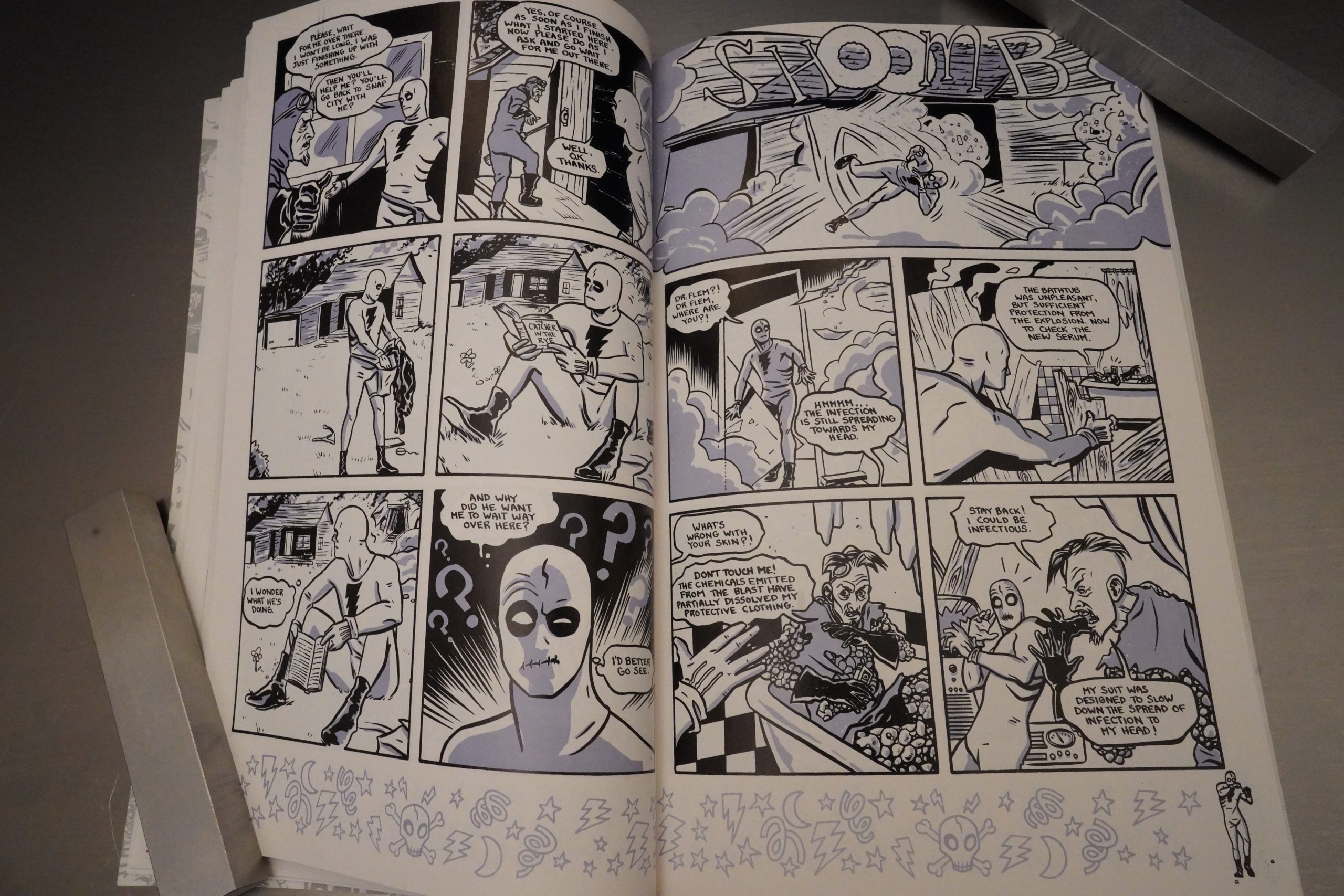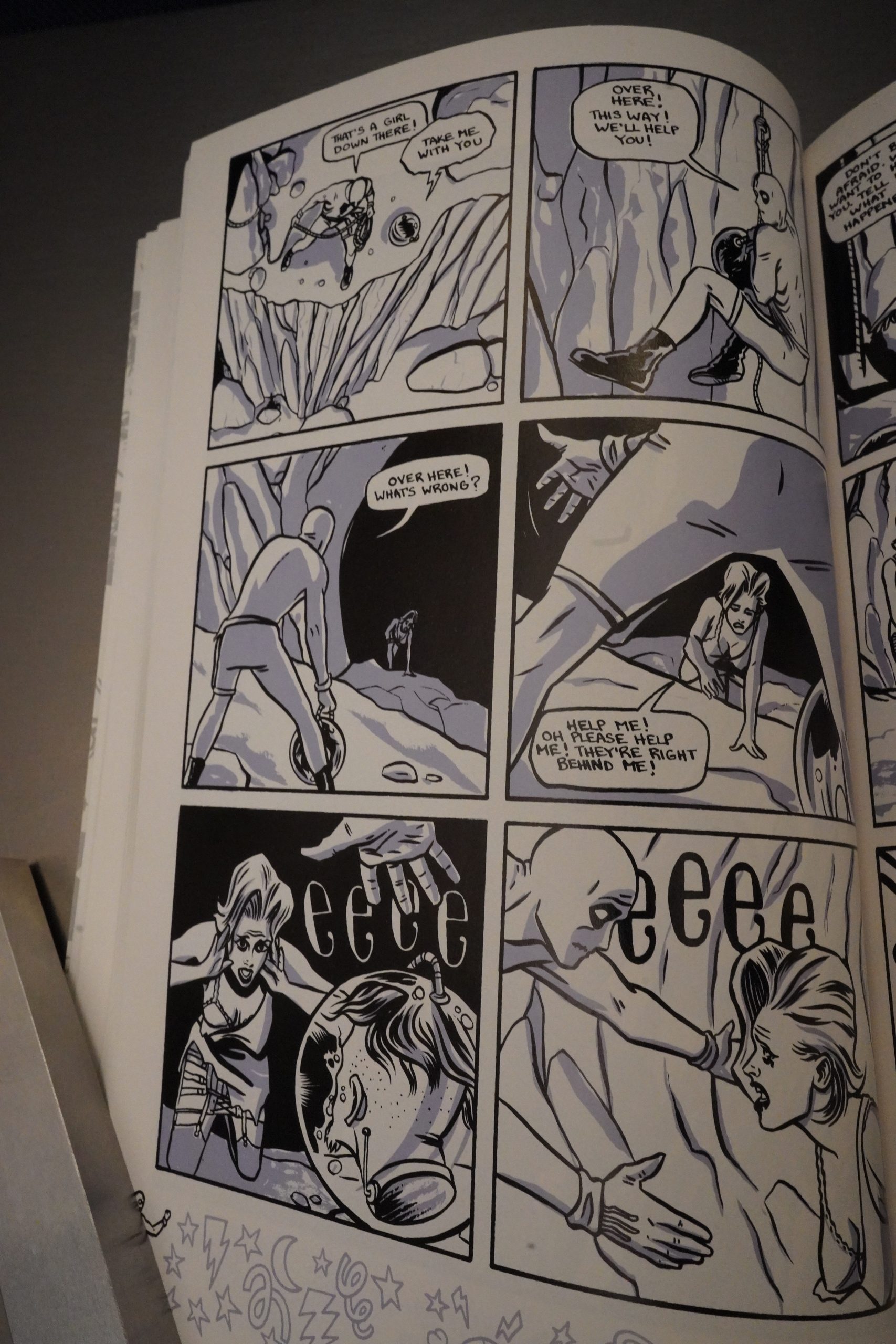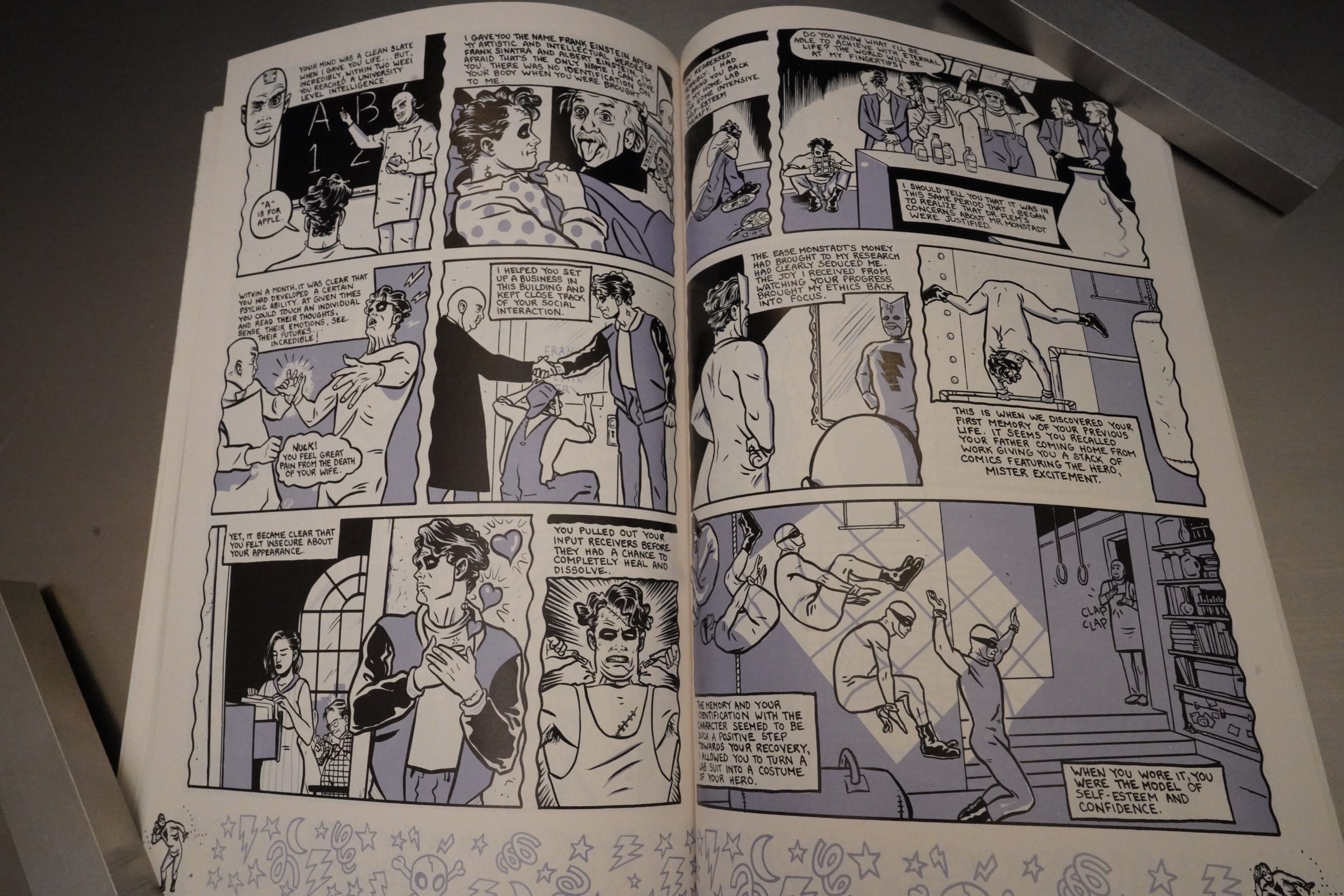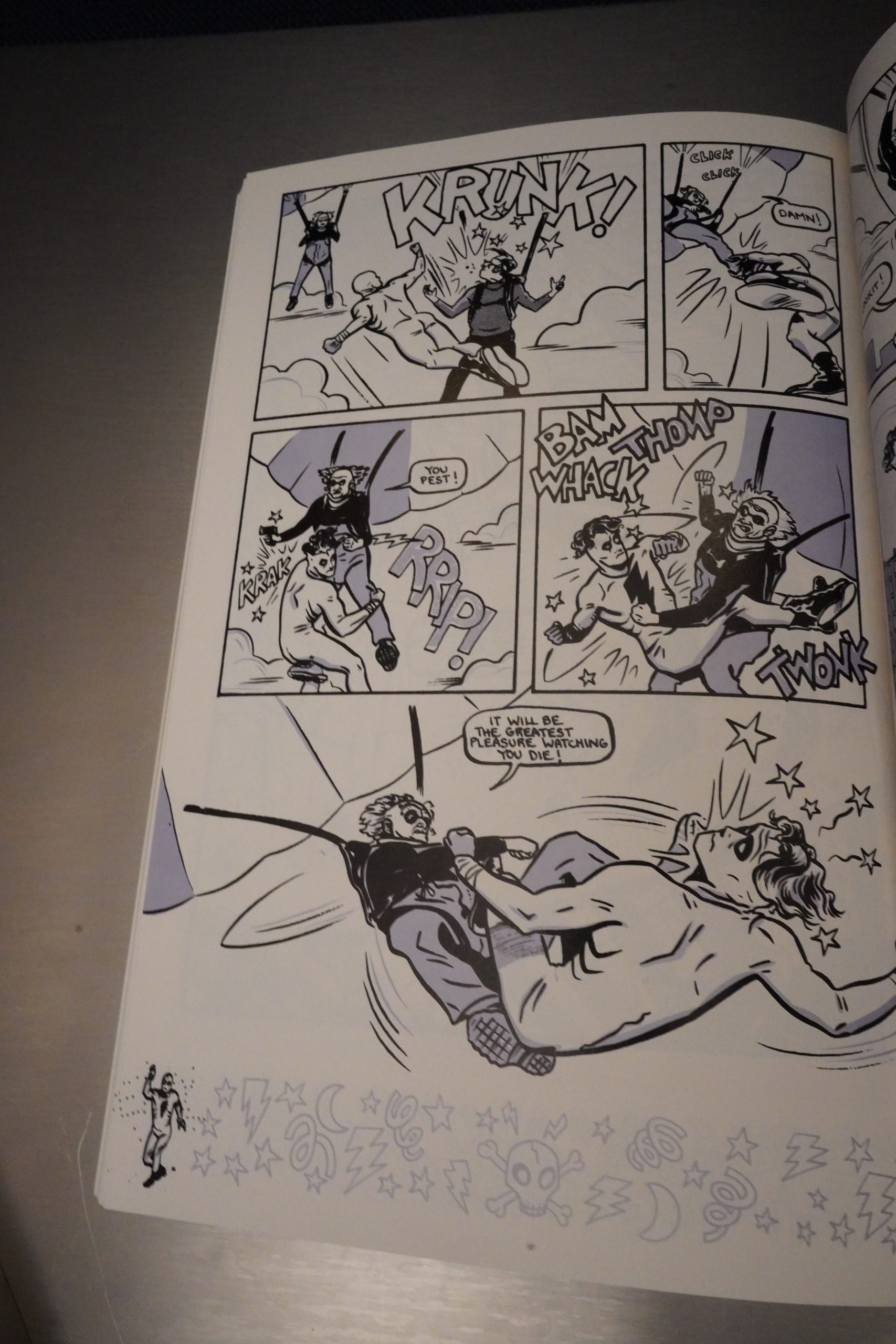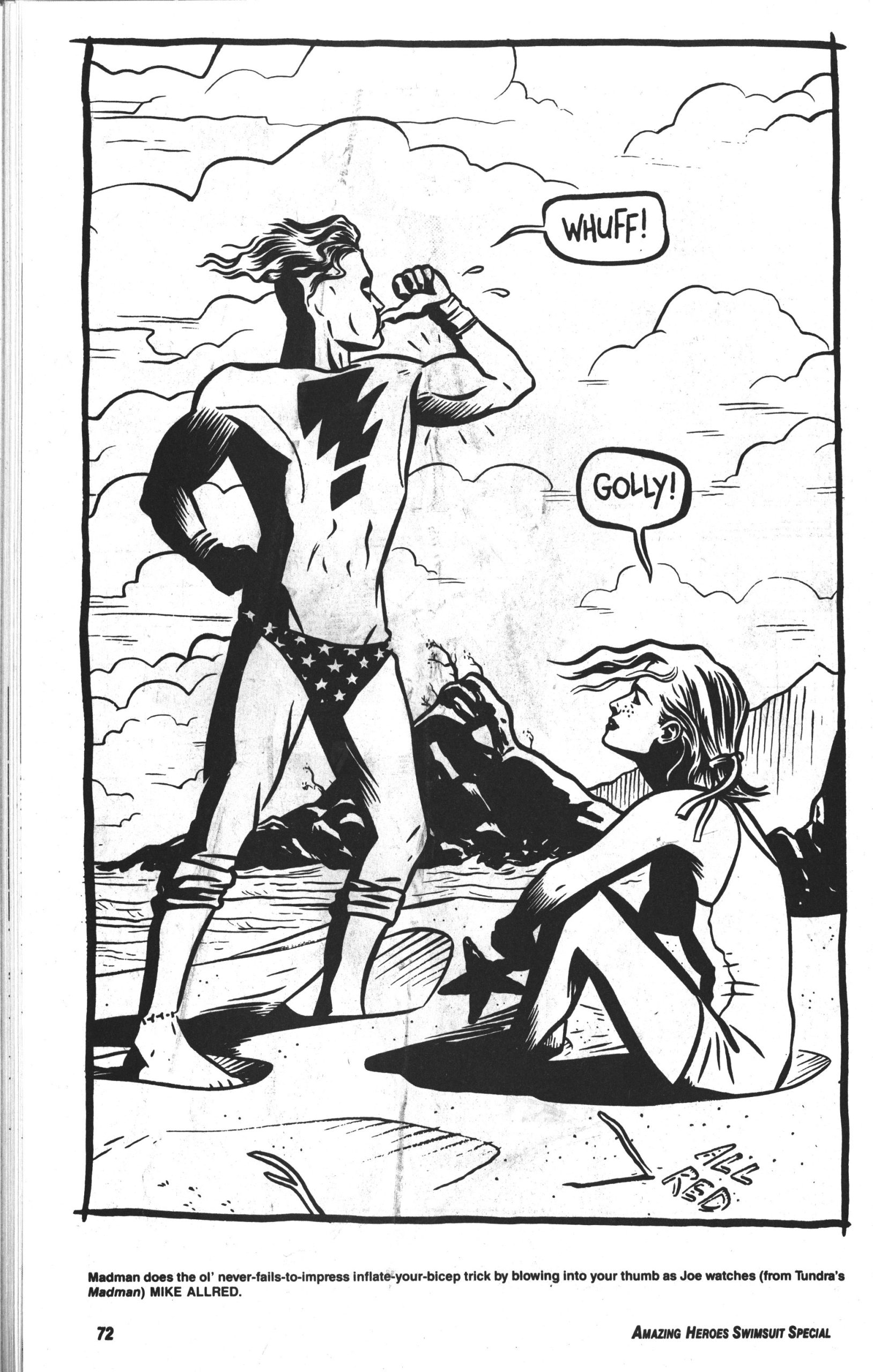
Cages (1993) #1-10 by Dave McKean
While doing research for some of the blog articles in this series, I happened upon somebody talking after the Tundra demise in an interview, and they were saying “so, what comics did they actually publish?” and the other guy went “I can’t even remember — isn’t that strange?”
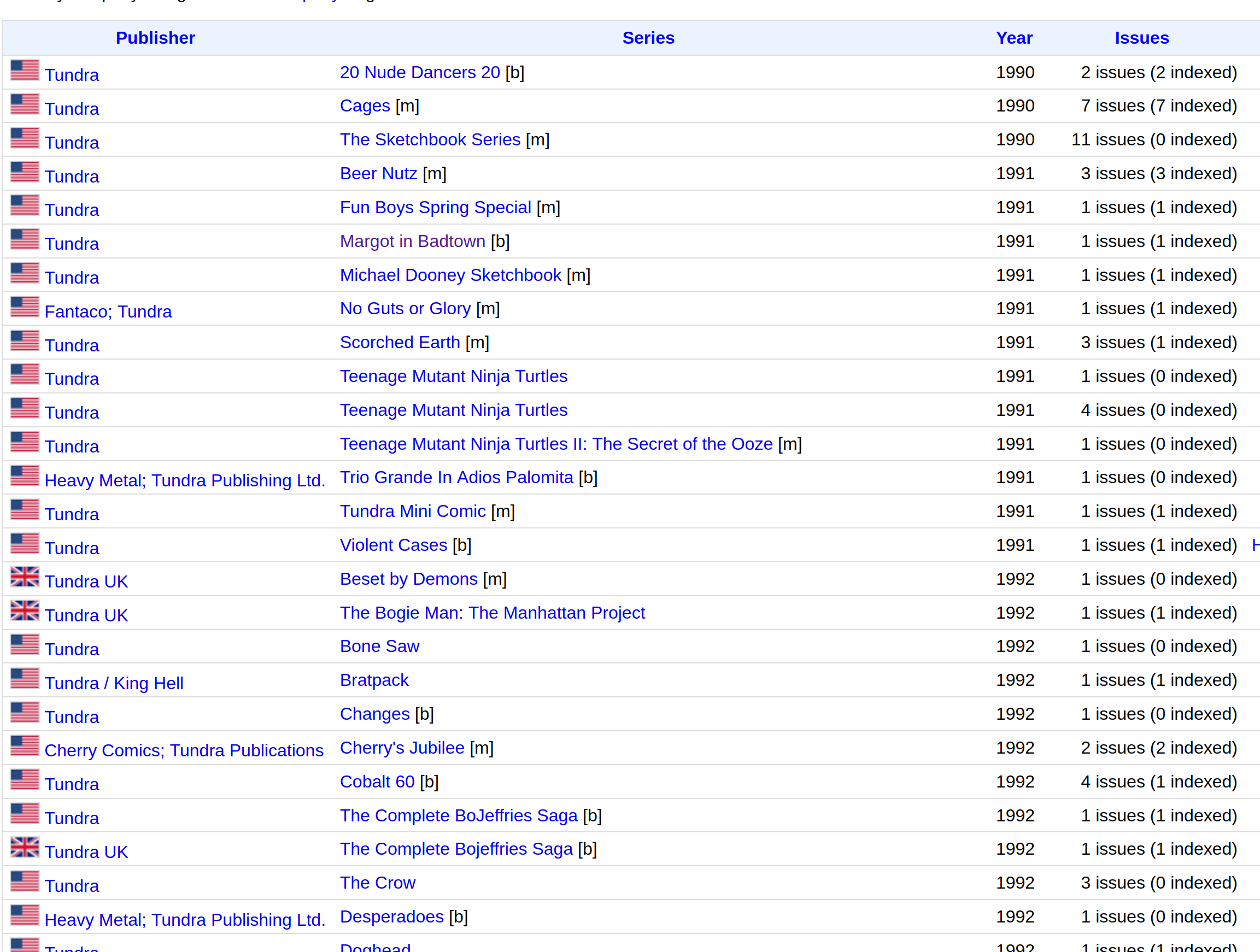
They published about 50 things, depending on how you count, and indeed: The vast majority of them made no splash in the public consciousness what-so-ever. Reading interviews with Kevin Eastman, who paid for it all (and reportedly lost $14M on the venture), his methodology seemed to be to reach out to artist friends, or artists who were friends of friends, and then go “here’s a huge wad of cash. Go make something awesome.” They took the cash, and some never returned any pages for him to publish, and some lethargically sent stuff back.
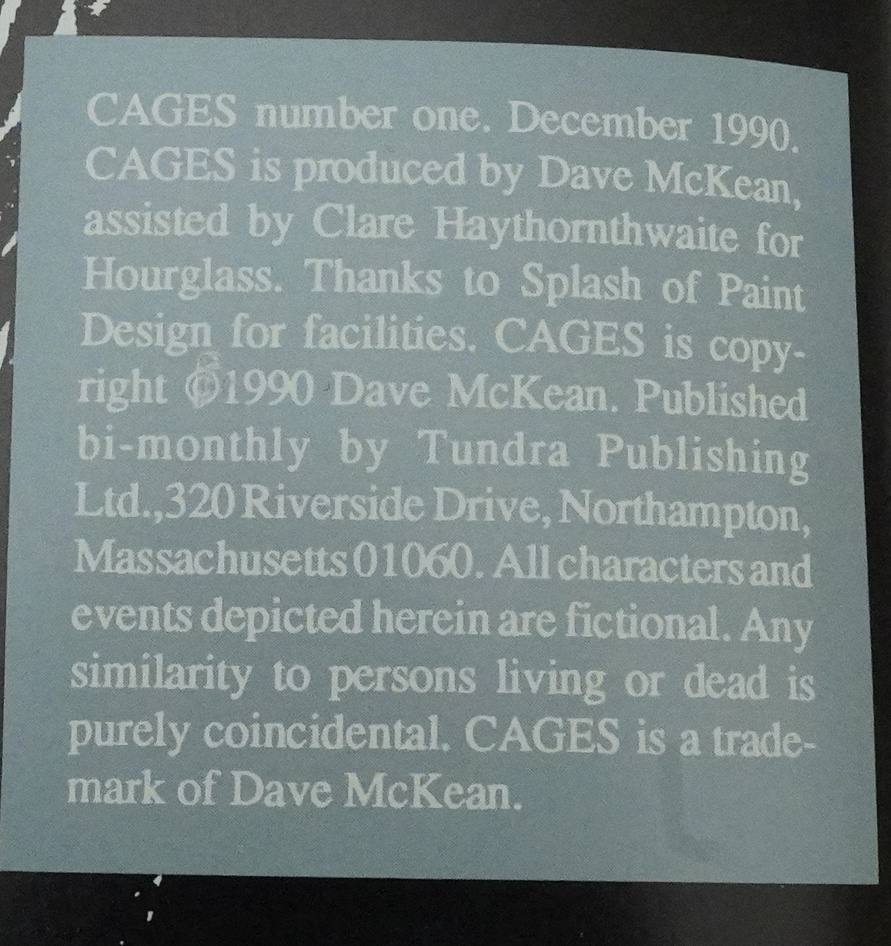
This was supposed to be a bi-monthly publication. Each issue is 48 pages long, and there’s occasional colour, but mostly black and white with a second, grey ink. How on Earth did anybody even vaguely imagine a bi-monthly schedule was feasible? (Except if McKean already had the 500 pages done, which he definitely hadn’t.) In a later interview, Eastman expressed disappointment in artists that just couldn’t stick to a schedule — any schedule, it didn’t matter whether it was monthly or yearly, but at least say what it’s going to be.
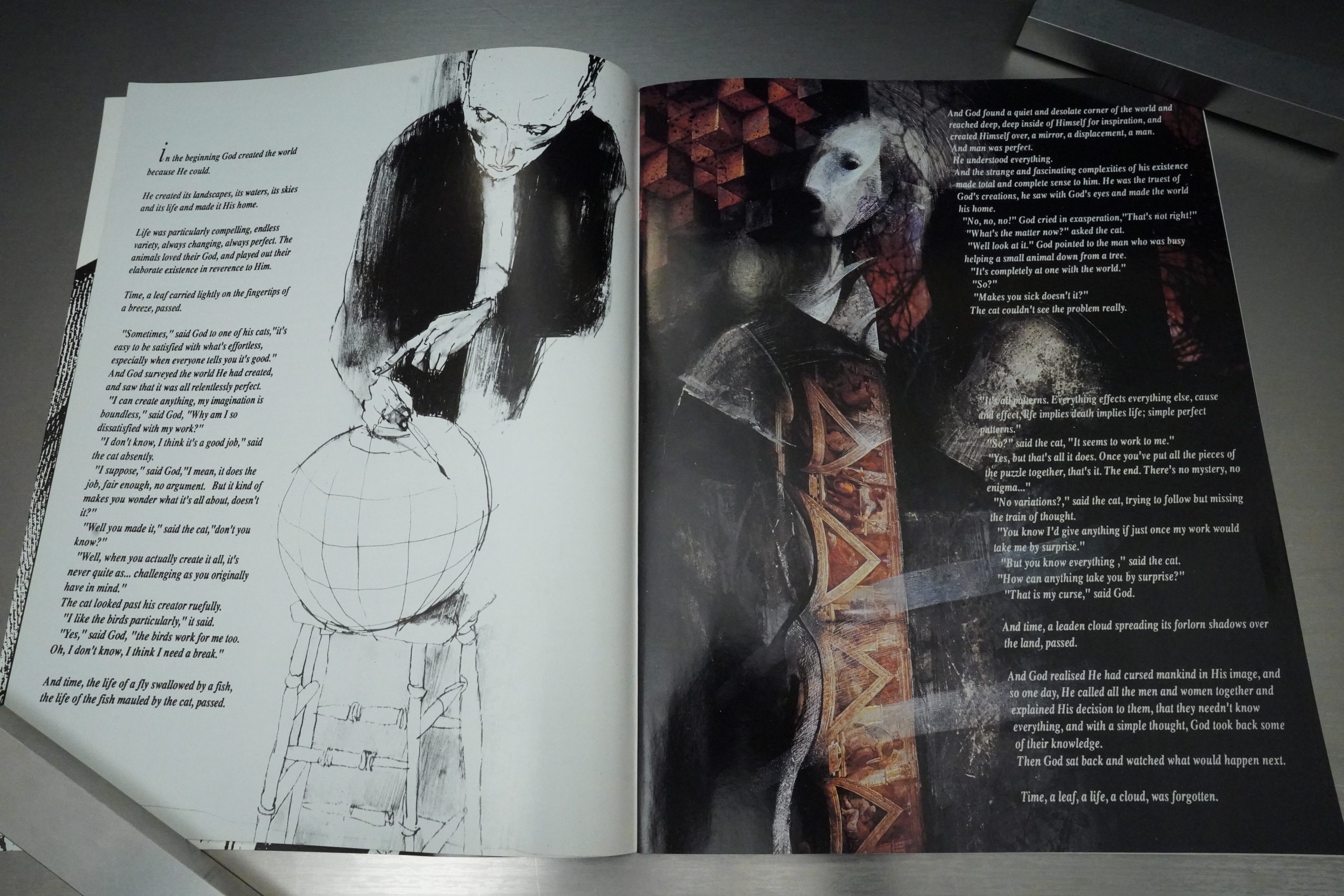
Now, of everything Tundra published, Cages is probably the most well-known comic. (Well, after Scott McCloud’s Understanding Comics.) McKean was famous at the time, mostly from the Neil Gaiman association, and (like many of the artists Eastman threw money at) hadn’t written anything before. And this is one of the few Tundra books I bought at the time, and I remember being quite impressed, but not by the start of the book, which is all christianey and gives a whole bunch of tweaks on the christian creation myth.
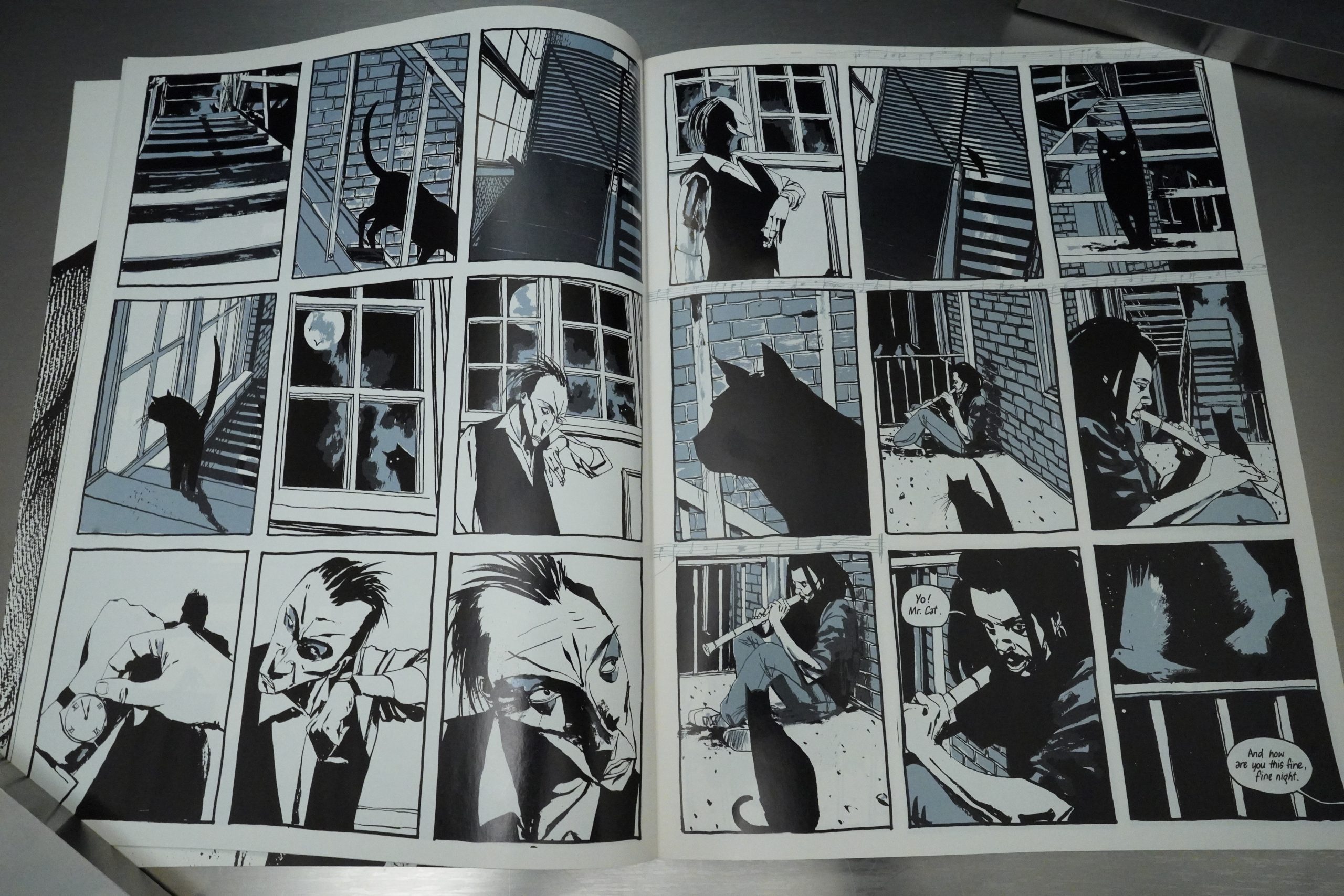
But when the book finally starts, it’s super sharp and intriguing. It’s got the then-fashionable nine panel grid going, and it’s printed with an extra ink — a grey that’s ever-so-slightly metallic? It looks really good.
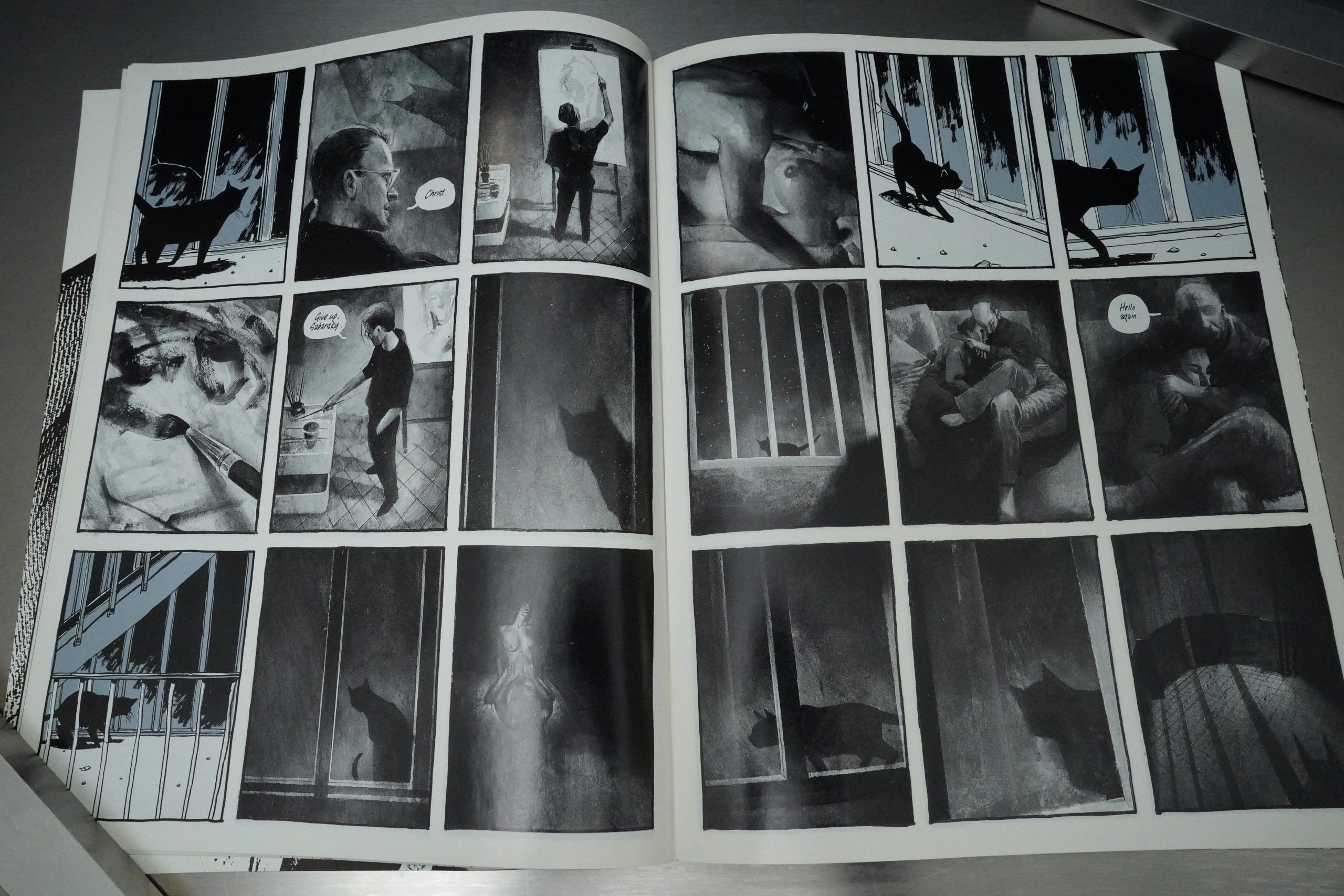
And it’s mysterious as hell, and has a cat that can apparently look into the past (that’s not immediately clear, but becomes obvious by the end of the first issue), and in the future, things are done in grey washes, because sure.
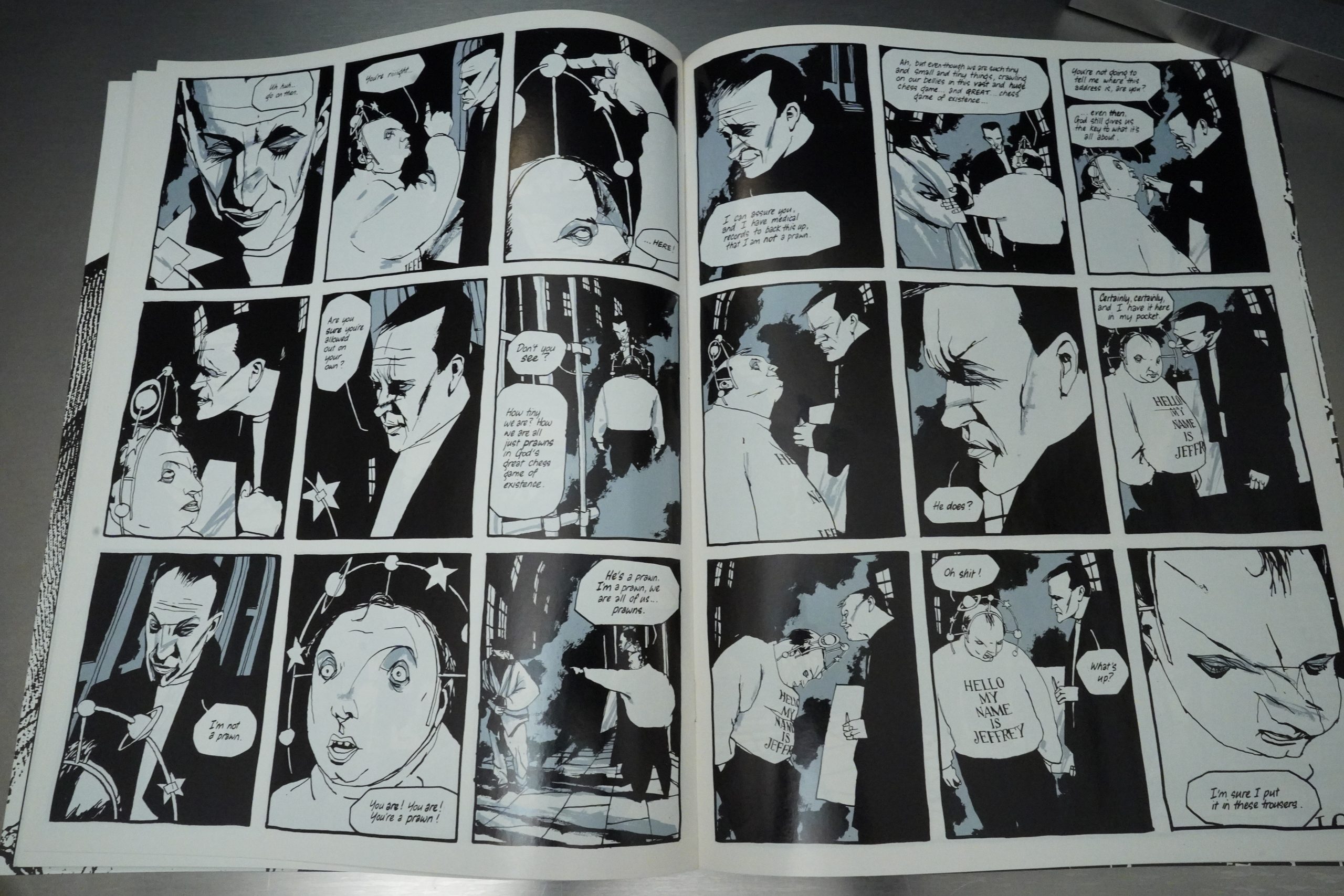
McKean ladles up one quirky character after another.
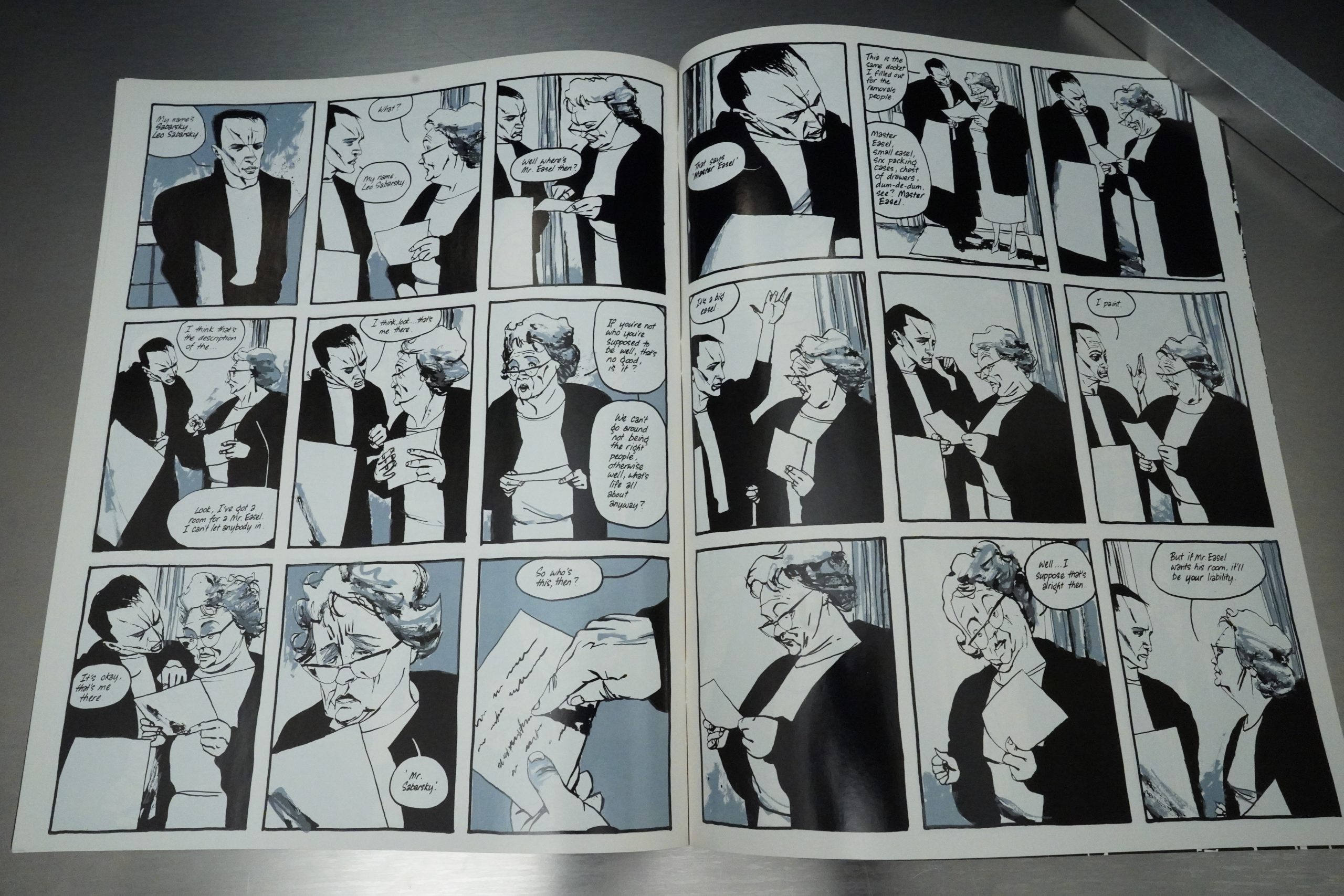
And he does several scenes of vaudeville schtick, and we never find out who’s on third.
It’s a really strong first issue — amazing artwork, many mysteries hinted at, and comedy routines at the drop of a hat.

So the second issue didn’t happen until six months later. But the next handful of issues did arrive quite promptly — three or four months in between, which I think is pretty impressive for a book of this kind.
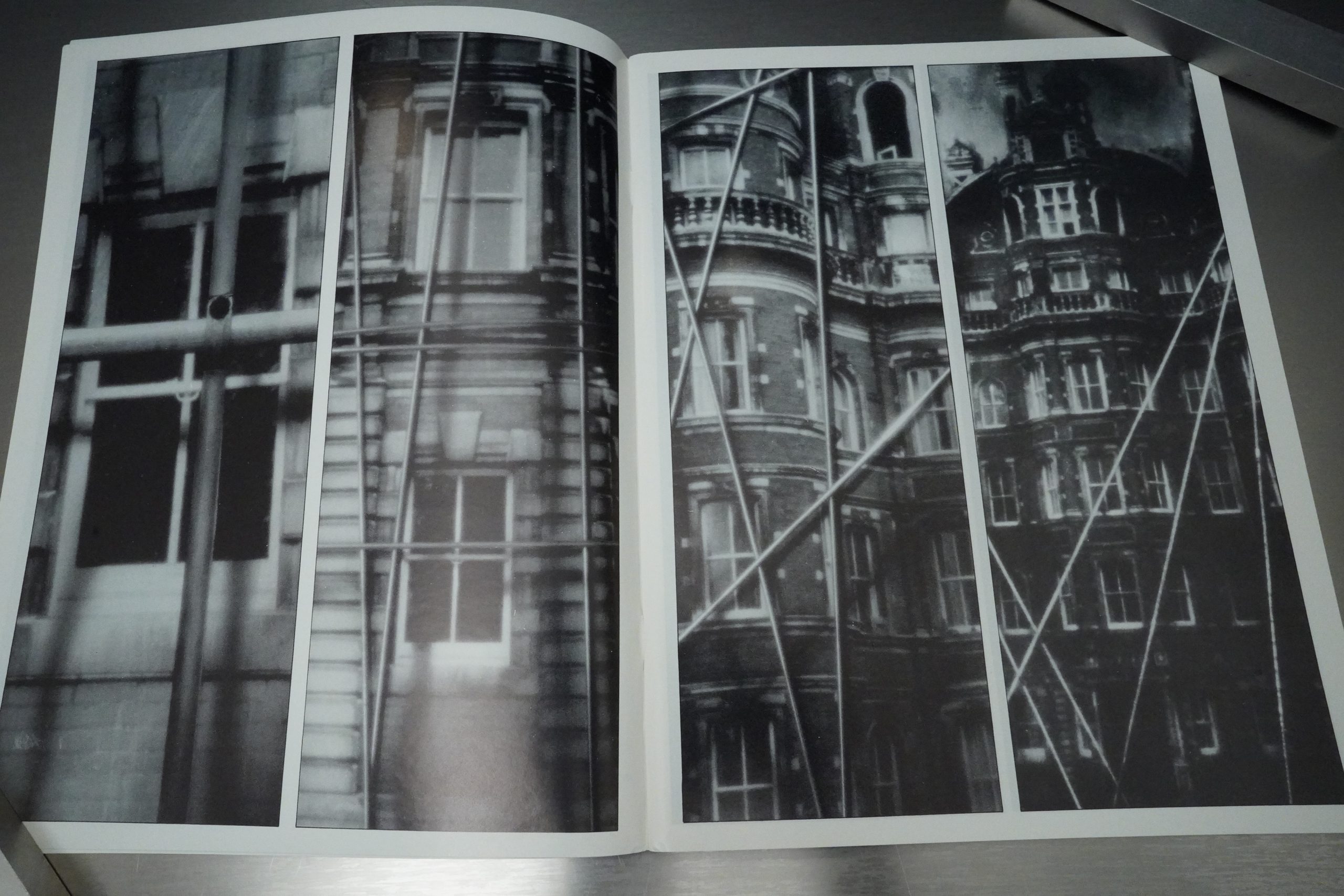
It’s also fun to see McKean just keep experimenting, and keeping things fresh.
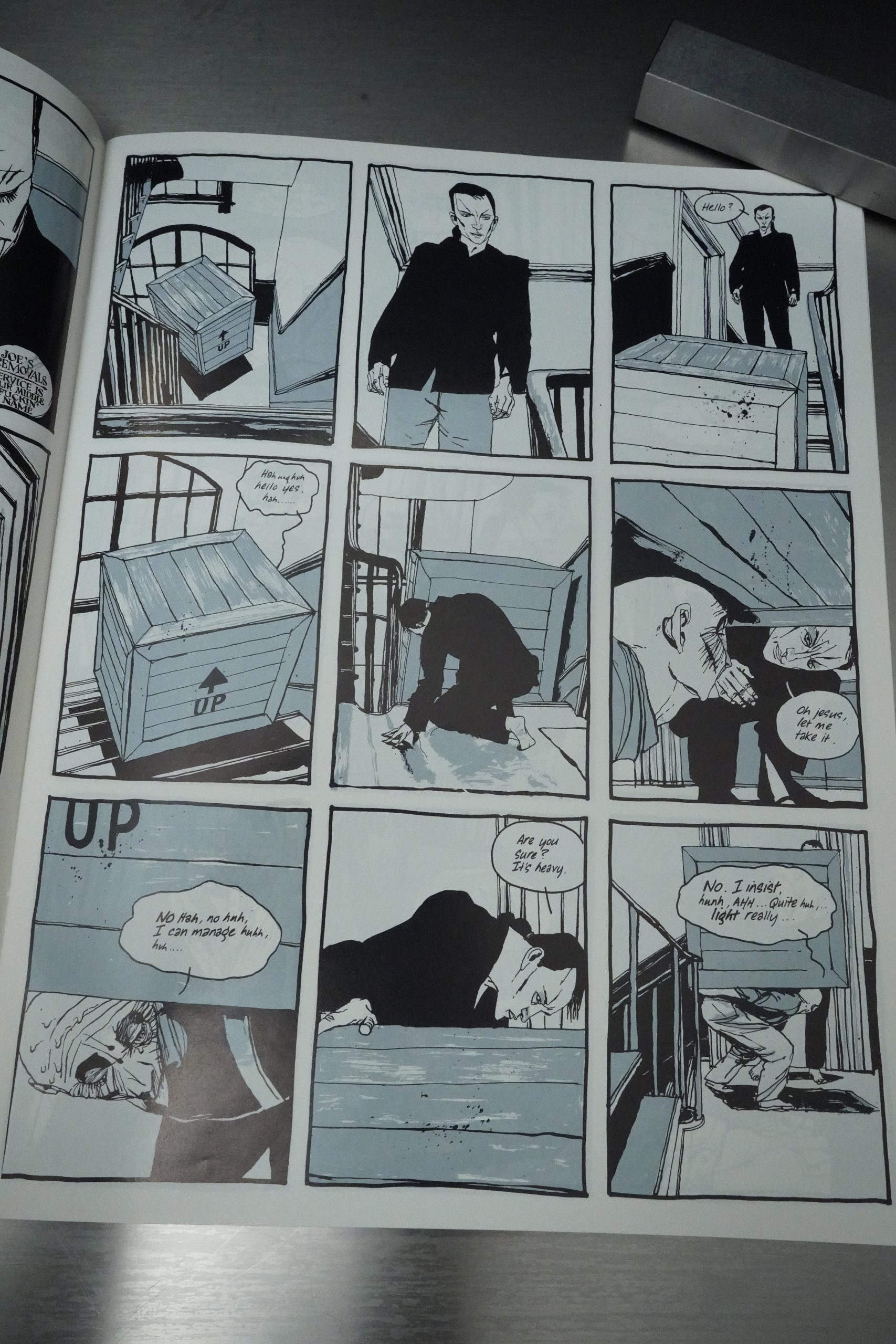
There’s a lot of bits that seems taken from real life, like being uncomfortable with having movers do stuff for you — but it’s taken one step further on, into either slapstick (above) or mysterious allegory (see many pages below). Some of it works, and some of it sticks out like “well, that’s an anecdote, but what does that have to do with anything” (above).
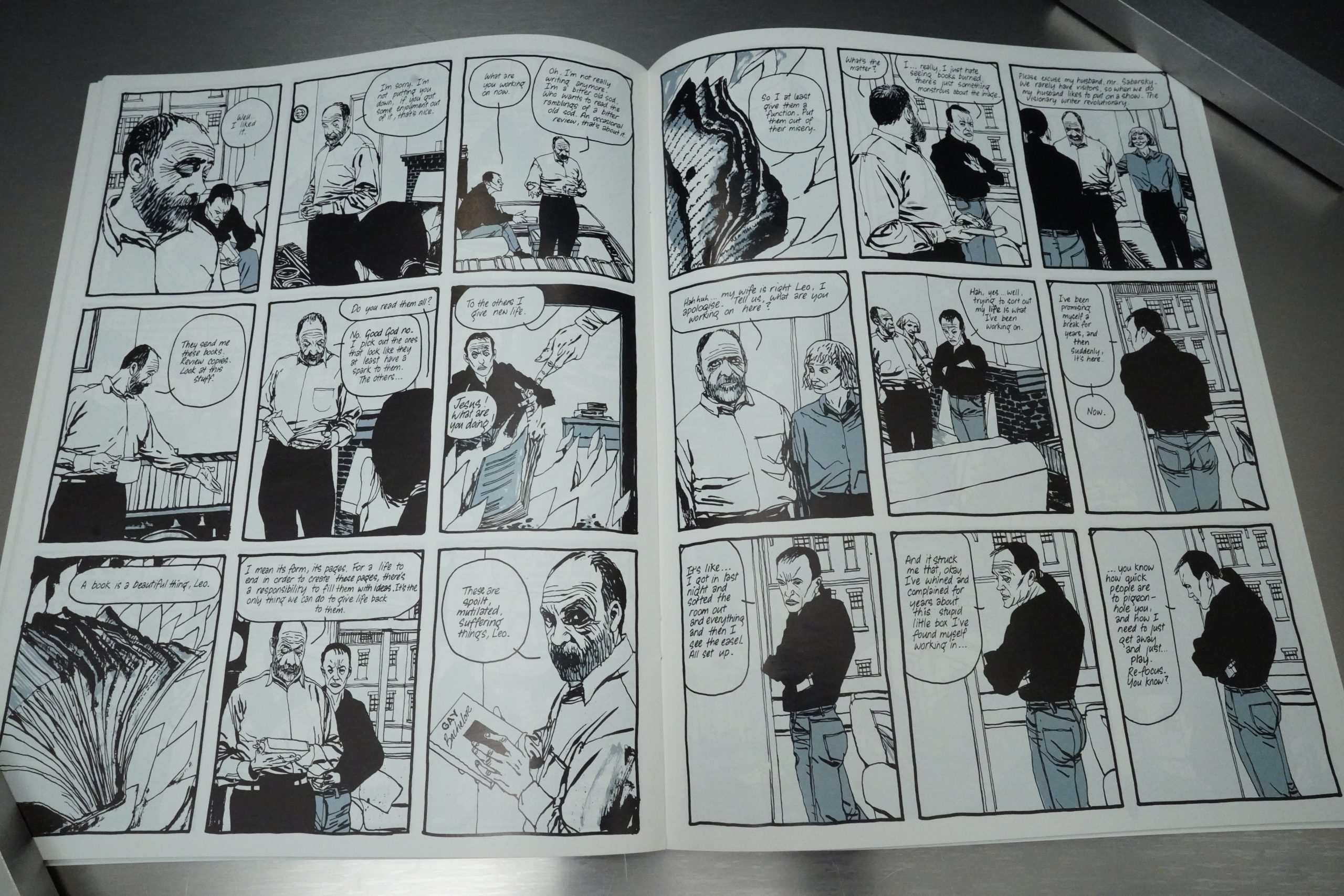
And while McKean has a real talent for 60s British social realist humour, I can’t really claim the same for when he’s seemingly trying for more naturalistic dialogue. It often seems stilted and unconvincing. But worse is when he tries to do prose, like in the excerpts from the genius writer — and it turns out to be pretty awful dreck. (But I don’t think it’s meant to be. It’s meant to be all deep and stuff. I think.)
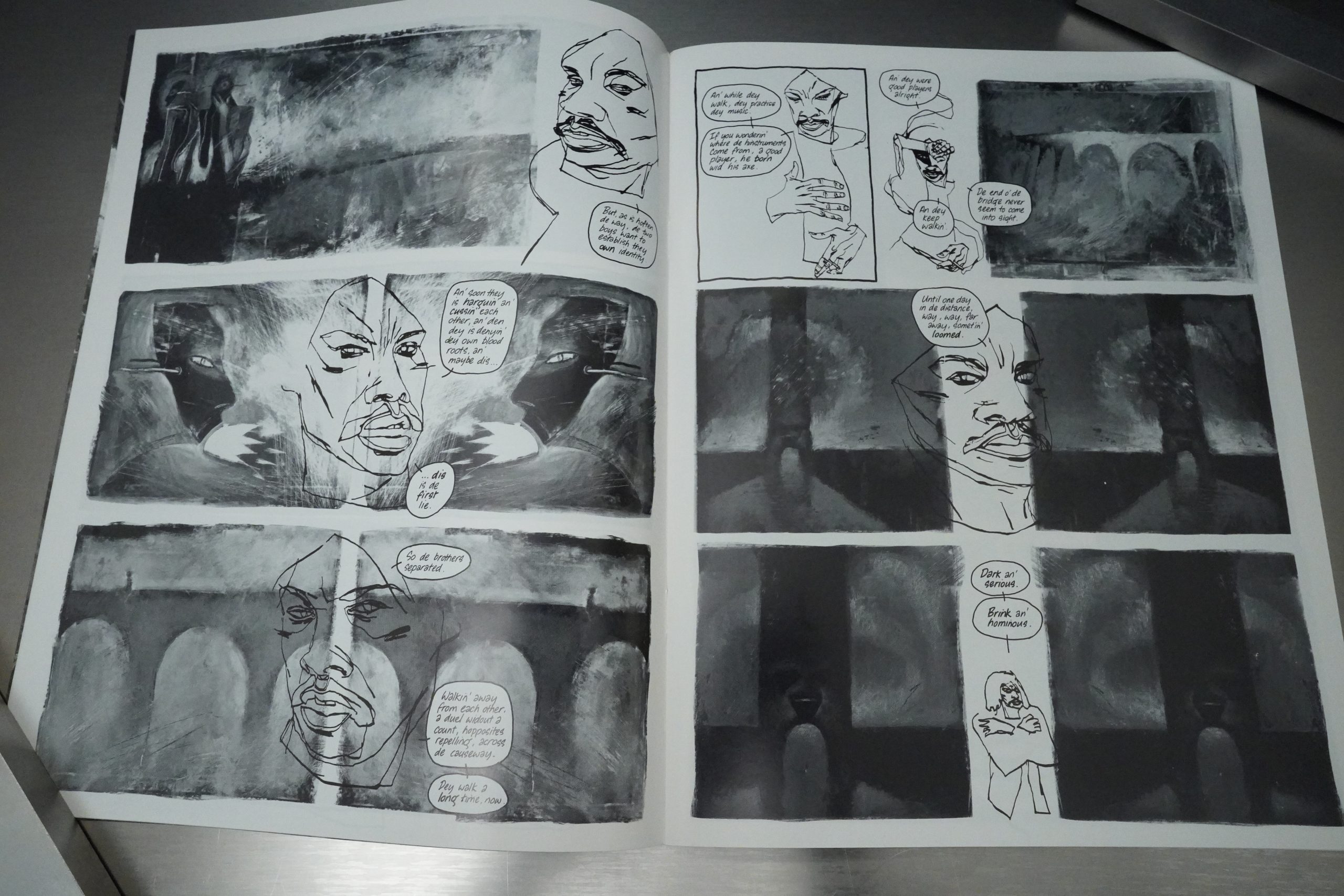
Worse is when he’s doing Caribbean dialects — “harguin'” and “lickle” etc sounds less like actual people speaking than awkward stereotype. Coupled with having this guy saying lots of Wise Stuff, it feels rather unfortunate.
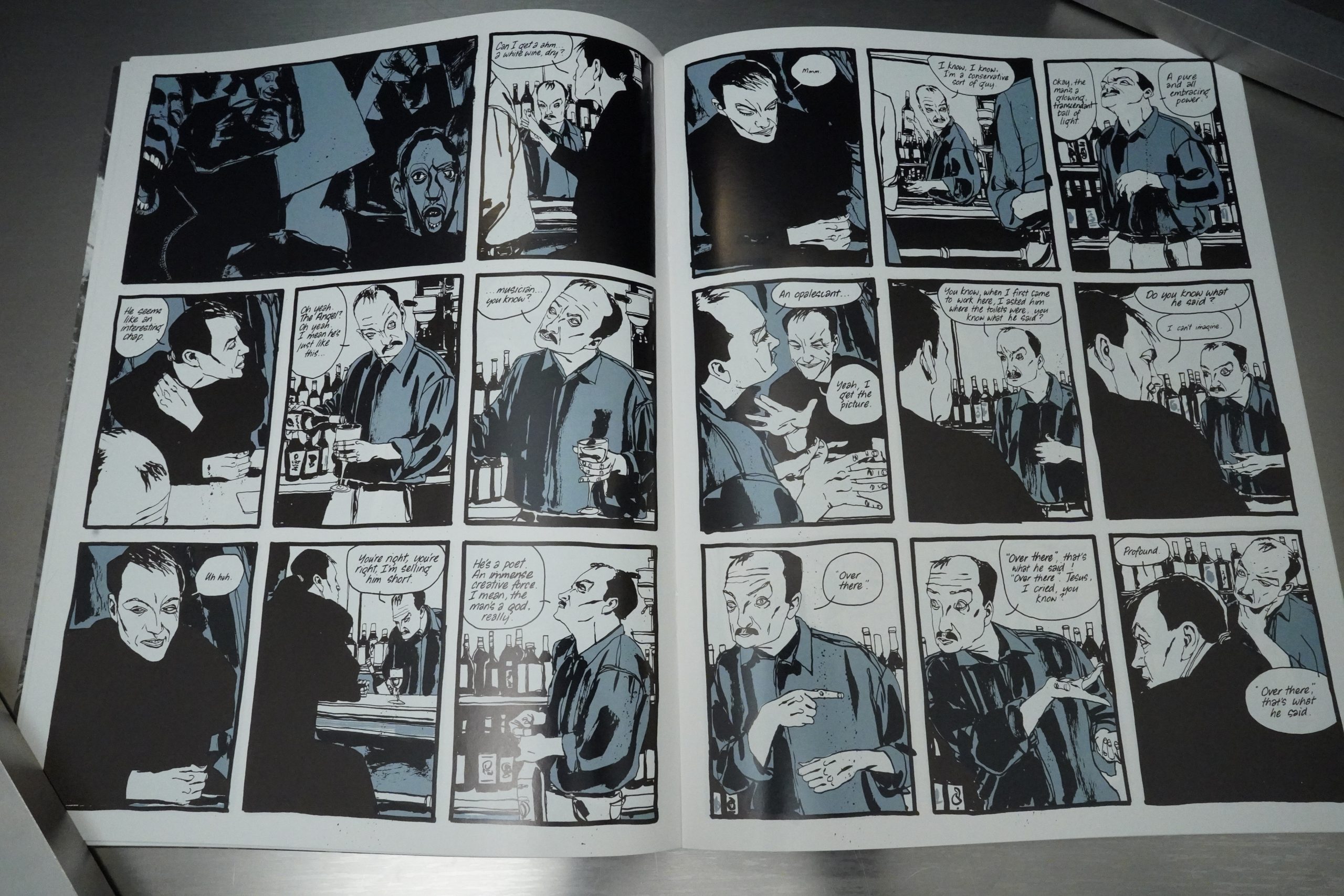
McKean is on safer grounds making fun of grouchy pub owners — these bits feel genuine.
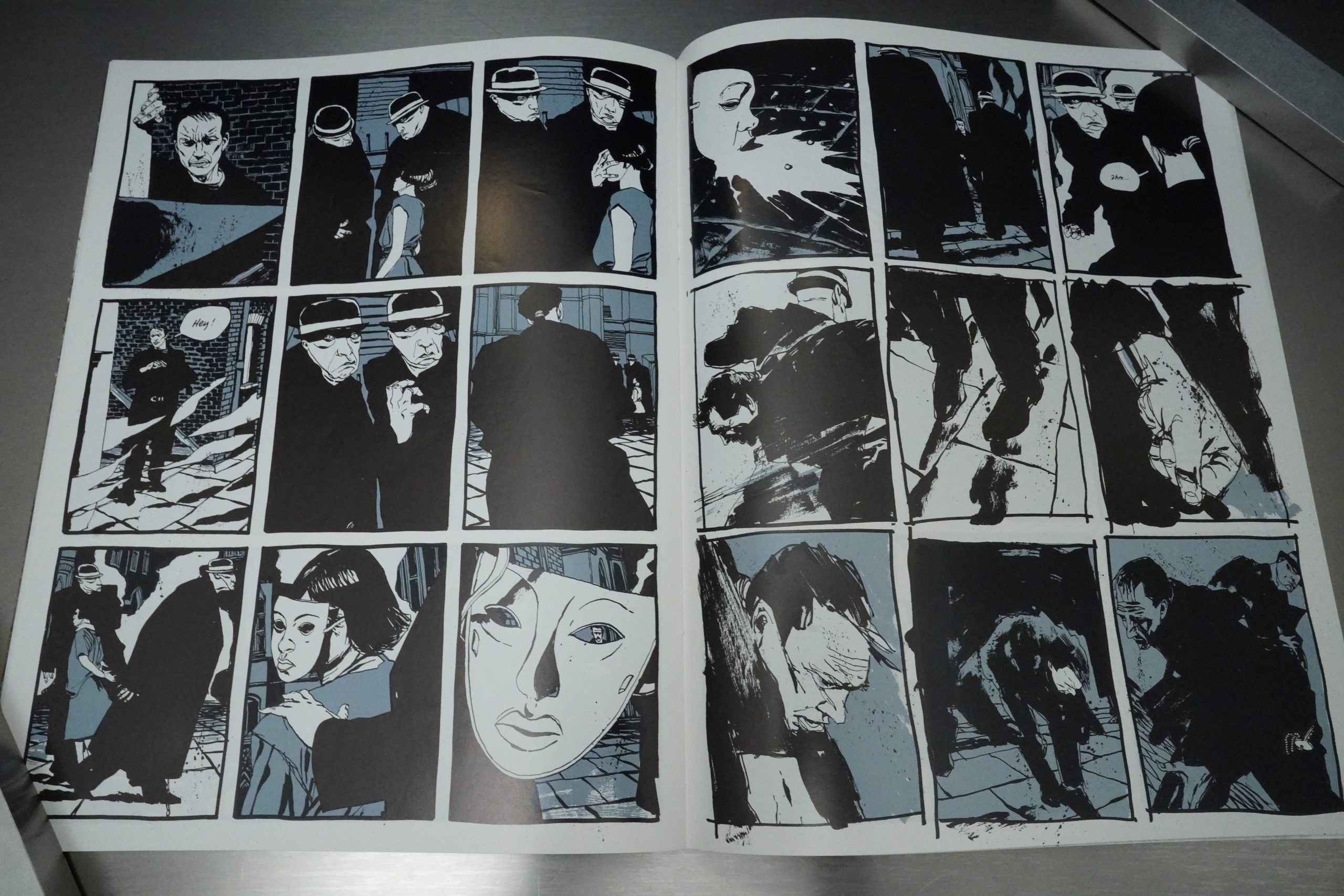
Halfway through this series, I started losing a bit faith in it. McKean introduces a bunch of mysteries, but as time passes, it becomes less and less obvious that he’s going to be able to tie much of this together. (I don’t think the scaffolding/alien creature was ever explained, but perhaps that was symbolic.)
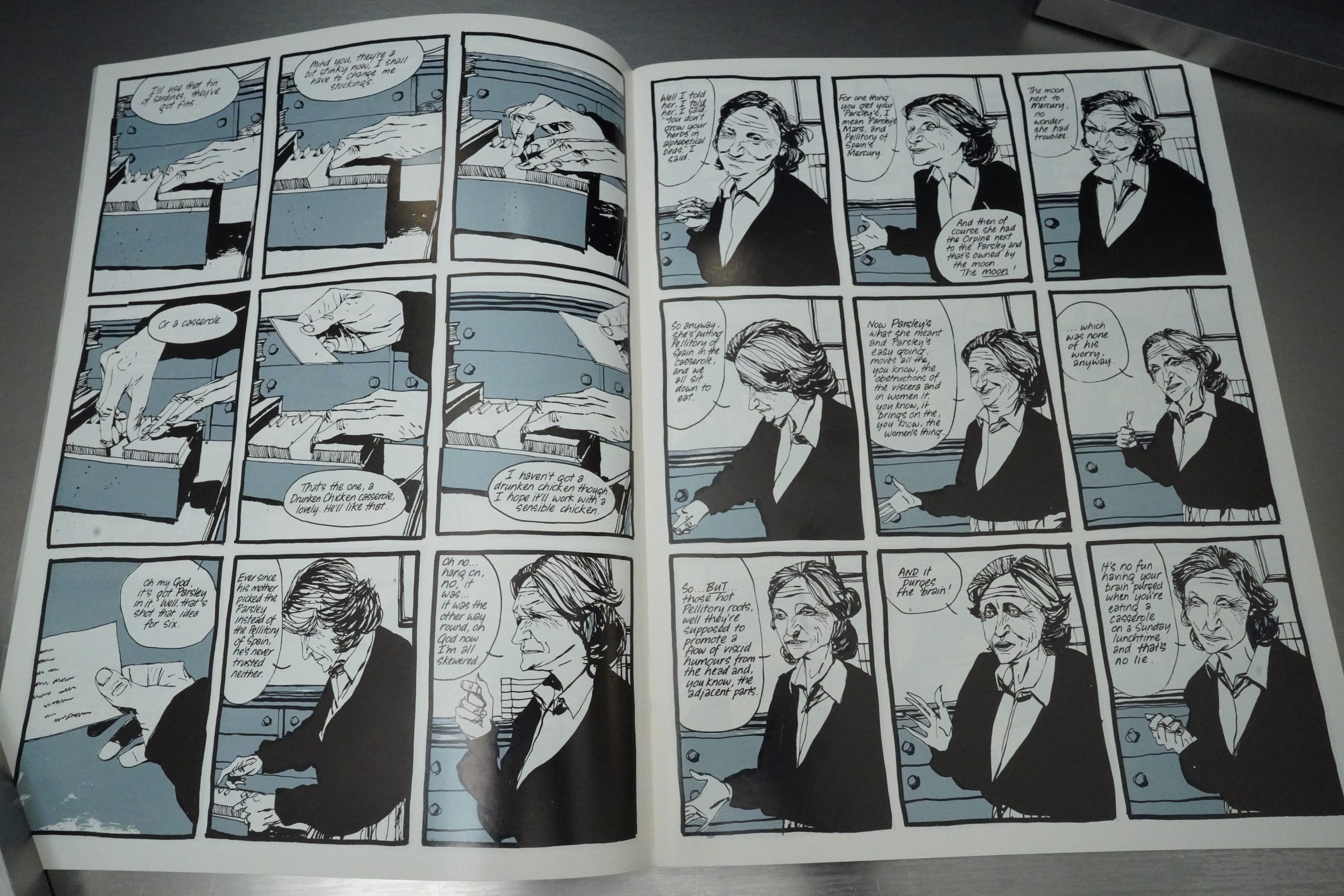
McKean spends an entire issue on trying to write a new episode in the Talking Heads series, but that’s no Patricia Routledge, and McKean is no Alan Bennett. Instead McKean adds a “twist ending” that you’d have to be brain damaged not to see coming, and that’s annoying. Especially since there is, indeed, a few bits in here that are moving and convincing.
(I watched all of Talking Heads (and all of Bennett’s earlier stuff) a couple years ago, which is perhaps this attempt at the genre was grating for me.)
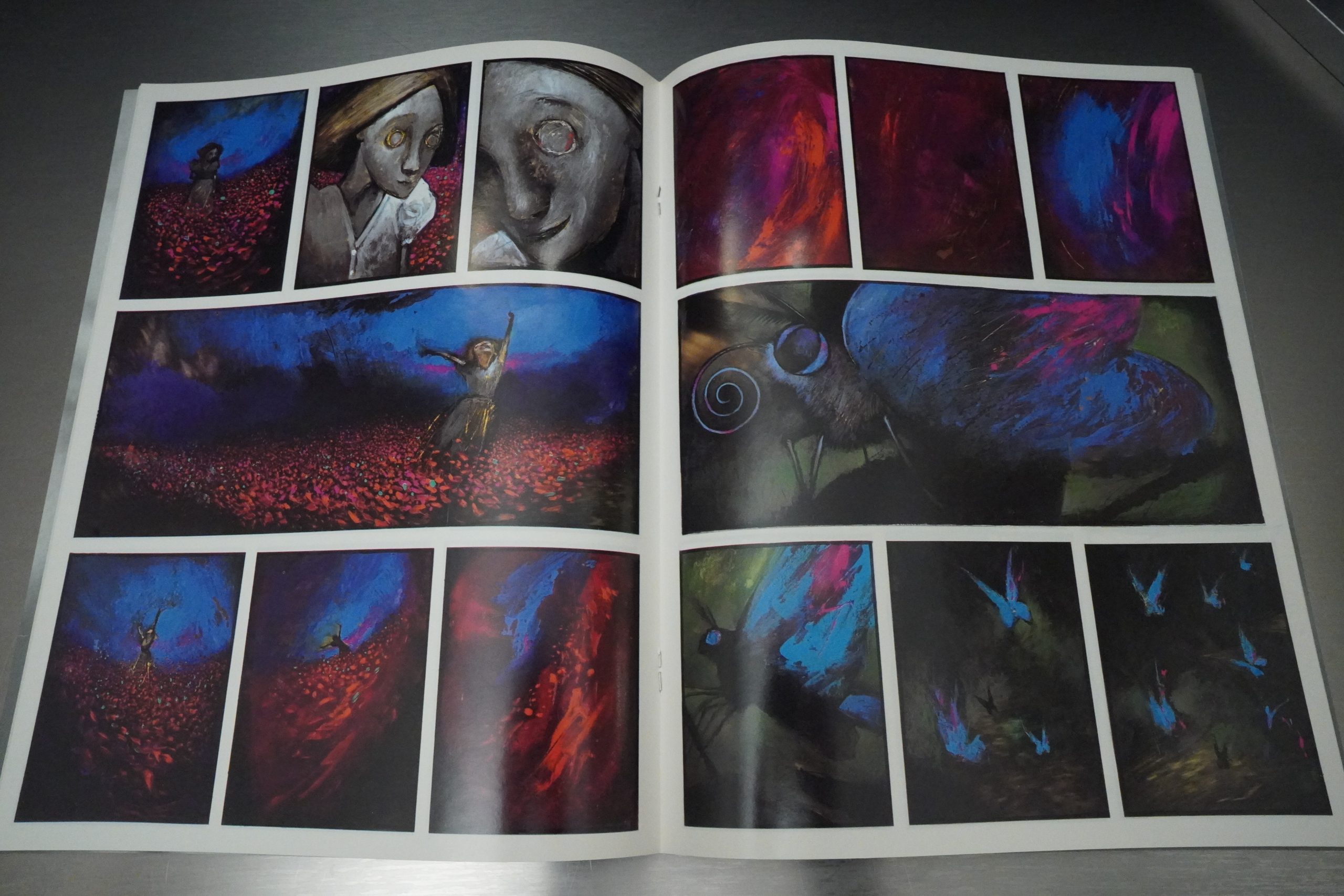
Tundra was not famous for being frugal, which is why it came as a surprise that the full colour bits here were restricted to the central sheet — so they could presumably print most of the sheets in two colour, and not add too much expense.
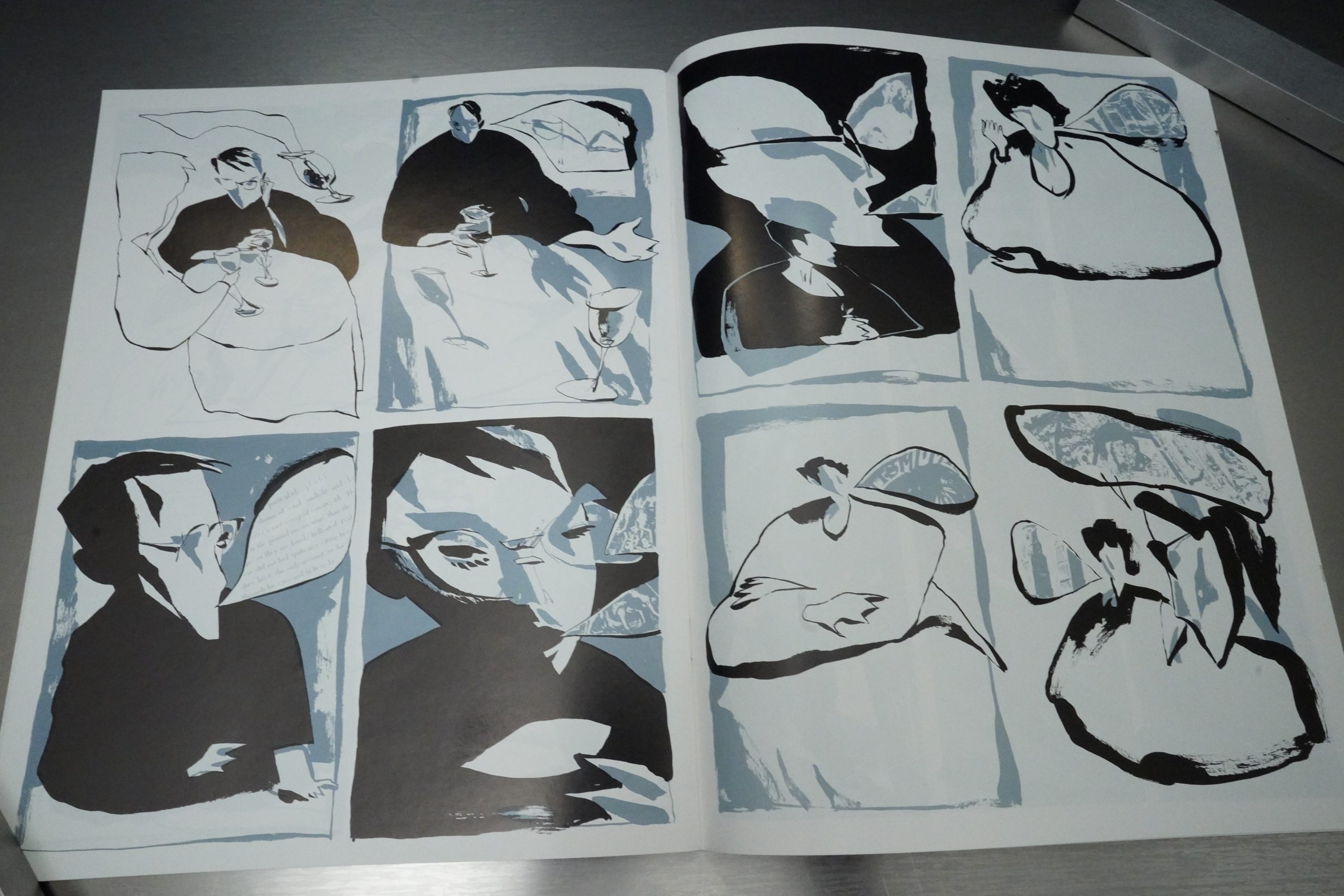
I feel like I’ve perhaps come off a bit too negative here — Cases is a good read, even if it’s not perfect. For instance, McKean going into this mode when the protagonist meets this woman and they start falling in love (while talking at a jazz cafe). It’s cool.
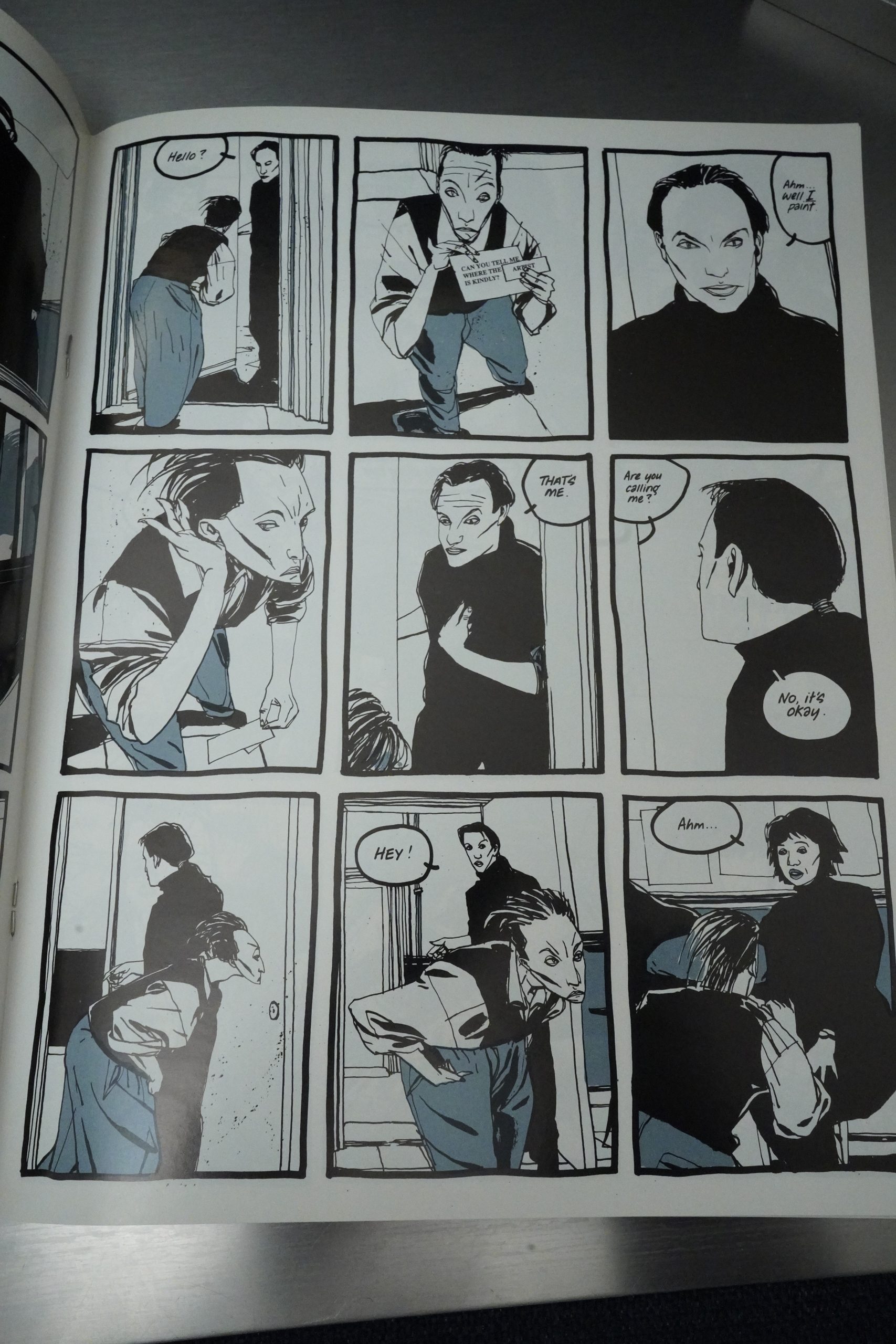
But again, McKean can’t resist piling on oddities even when he’s got too many already than he knows how to deal with.

And, of course — all proper Comics Artistes (who know how to draw a hand) have to get a crack in at That Awful Modern Art These Days.

It turns out that one of the characters is a Salman Rushdie type of author, but instead of just being hunted by religious extremists, somehow he’s also being persecuted by the government? It’s just weird, and the resolution to this bit is that The Protagonist (oh, did I mention that he’s an artist?) offers to let him live in his girlfriend’s apartment instead. Case Solved.

Three years pass between the eight and the ninth issues. By 1996, Kitchen Sink was in deep doo-doo, and had been sold at least once, so I guess we should be grateful that they even published the final two issues. But I wonder what happened in those three years — did McKean have to find a paying gig because the Eastman checks dried up?
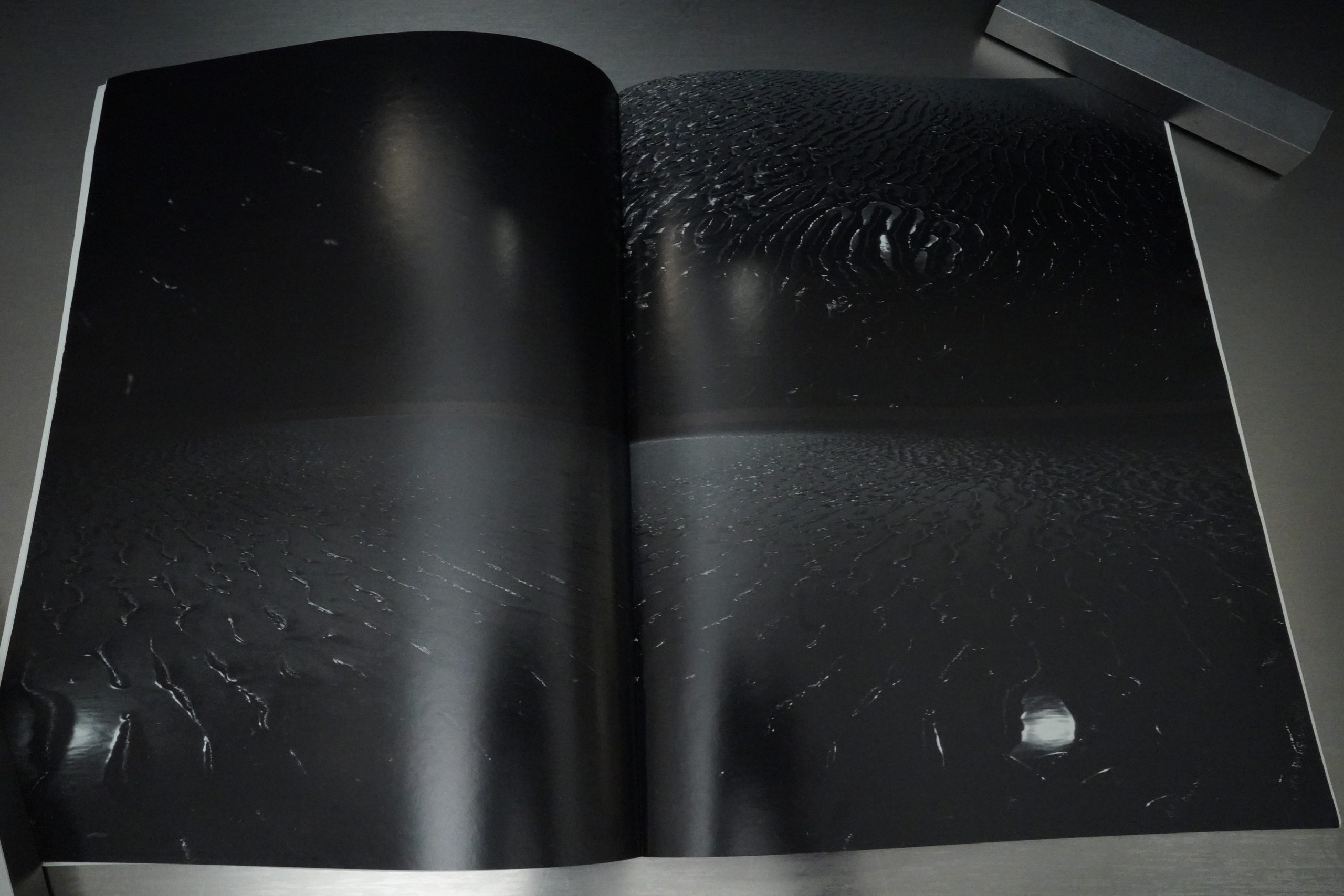
And the final two issues seem a lot less work intensive than the previous ones.
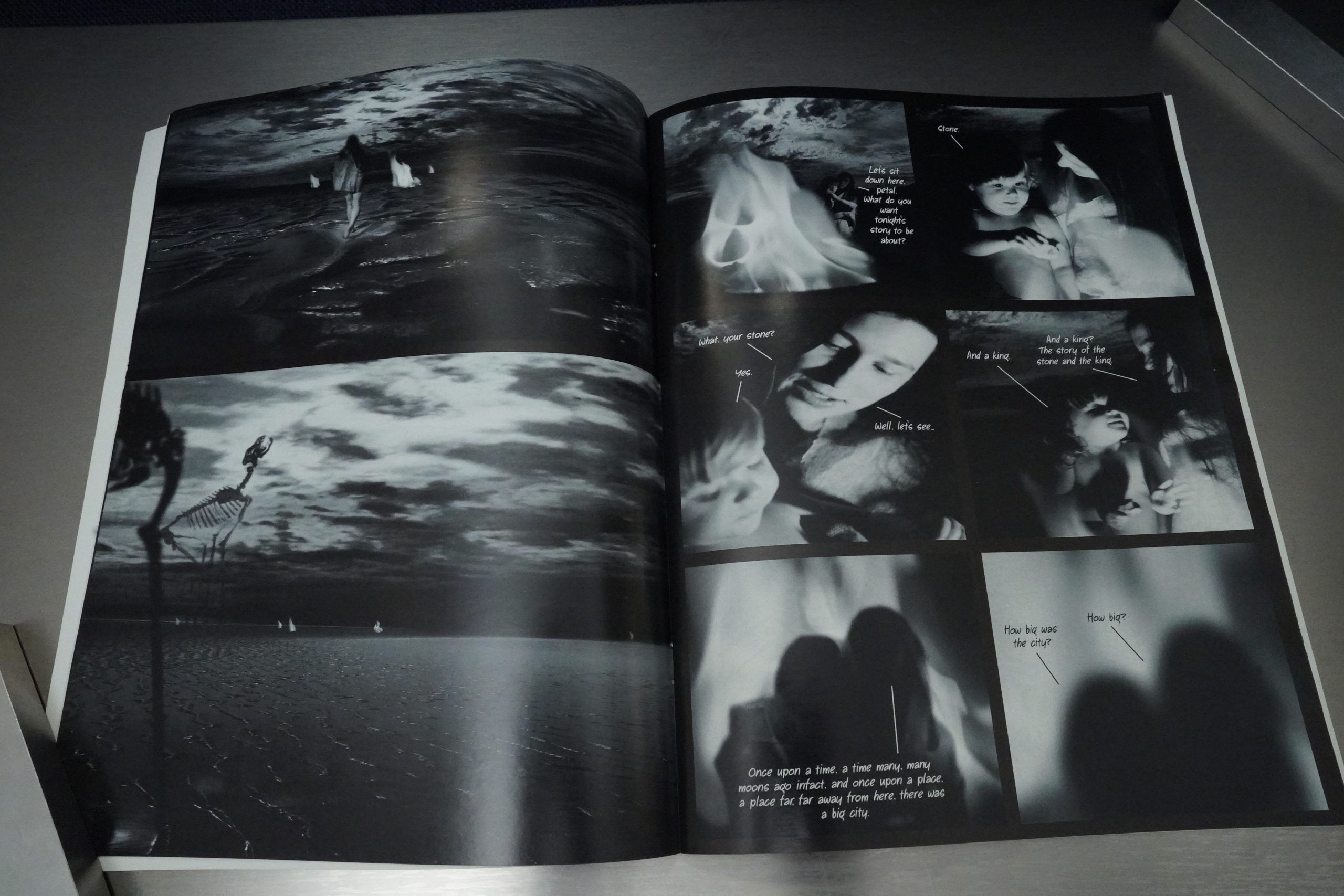
McKean still seems to be experimenting, but more with a focus on not actually having to work that much.
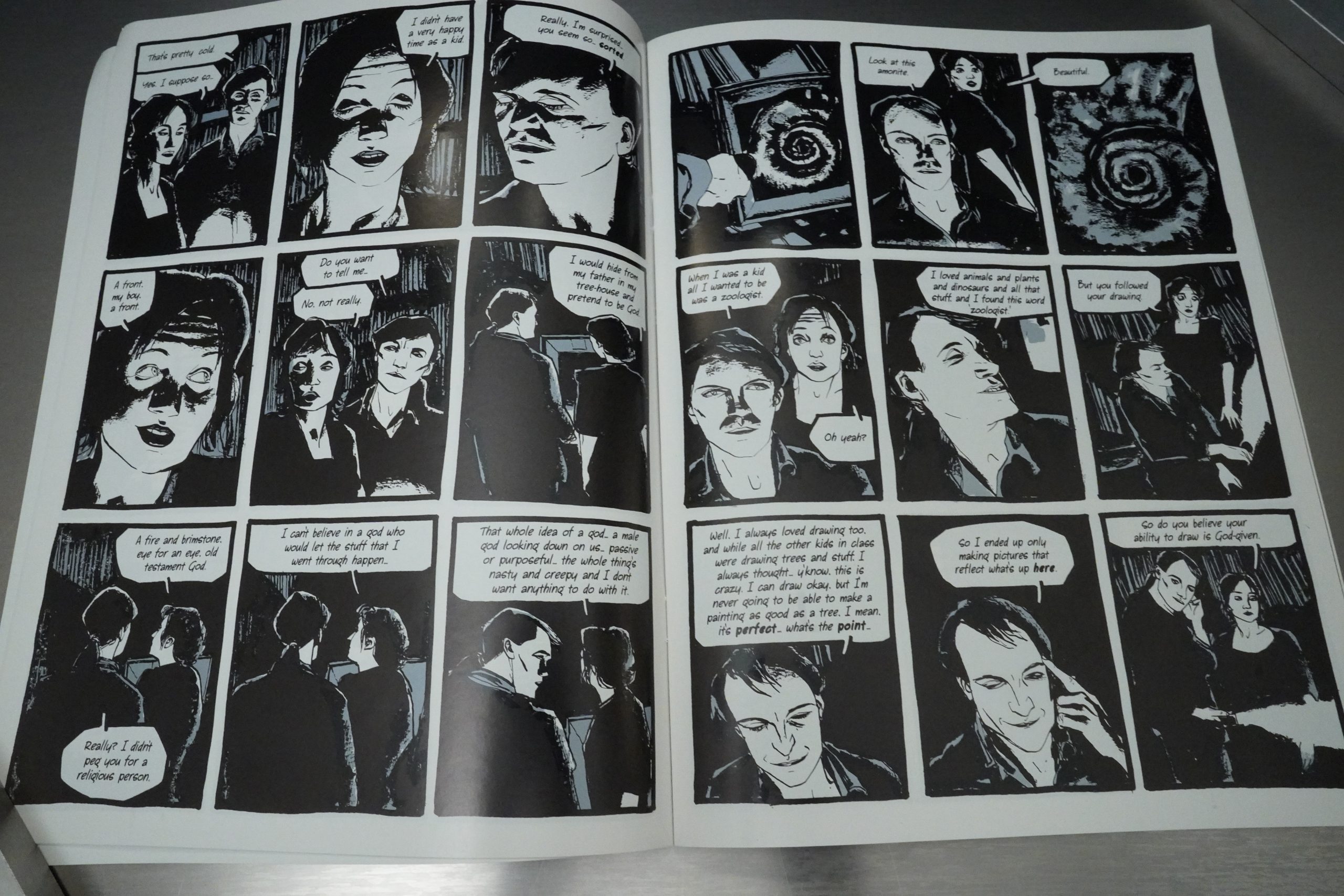
And his drawing style (when he actually draws) seems to have changed enormously, too.
Does he stick the ending? Well… he resolves a couple of things nicely (like the cat/Bill/the Talking Heads woman turns out to be connected), but as expected, most things are skipped over. Perhaps that’s planned (to not make the ending too pat, with every thread resolved), but…
So is it a good book? Yes. It’s interesting. It’s got great art, and it’s got several really funny bits. And it’s got some mysteries that were hinted at efficiently, but not really resolved very well.
Eastman is interviewed in The Comics Journal #202, page 85:
GROTH: Here’s something that again I can’t quitefathom
this happen or be to happen. In the
minutes Of a May 21, 1991 meeting, you record the
following. Cages ispresentlysellingat $3.50. It has been
determined that Tundra loses five cents an every copy
Cages that it sells. Greg willspeak with Dave andlet him
knou that Tundra wants to increase the cover price to
$3.95 starting uith issue And then a little later, •It
has been brought to the attentiøn of the team, that out of
eight books that •uere printed in 1990, only three Of them
couldpssibly make money, and that only fall the copies
were sold. It ü.ws discovered that in certain cases, Tundra’s
actually losing money on eath book we sell.
[…]
GROTH: Well, there are some projects that you actually
spent more moneypromoting than What they grossed
EASTMAN: Yeah, we were desperate, as in “we’re here,
we’re here, we’re here!”
GROT-H: A really blatant example is thatyou
EASTMAN: Mm-hm.
GROTH: And according toyour ownfigures, whith I think
are conservative, you have to sell copies to
break even. But you only printed 13, 0m.
EASTMAN: Because thaés what we had orders for —
GROTY: 6500.
EASTMAN: Right.
GROTH: Soyou couldn’tpossibly bøve broken even on that.
EASTMAN: NO. In our evaluations, we tried to estimate
what we thought the industry standard for this kind of
more mainstream book might be, how many we’d have
to print, and how many we’d have to break even. We
felt that the book would easily go beyond 20,000
copies and it didn’t.
Marc Weidenbaum writes in The Comics Journal #142, page 58:
Unlike Arkham Asylum, whose title page ex-
hits more creative tension than its entire
storyline, Cages’ remarkable initial issue (nine
to follow) has no title page. The series opens
with a black page. Not a stylized, four-color
black page decorated with sharp, elegant type,
but a shitty black background covered with text
that looks as if it was set on a home computer.
McKean may have sublimated the urge to
splurge graphically, but for his first effort as
writer/illustrator, he has certainly opted for big
topics: the origin of the universe, God, stuff like
that. He paints a highly memorable, insular
portrait of reality in which a lone apartment
building appears not simply as the focal point
of the universe, but as the summation of
existence.
The series’ first issue starts with a lengthy
prologue consisting of four brief, bittersweet
creation myths, appropriately titled “Scaffold-
ing.” That’s exactly what it is: a bare-bones col-
lection of stories essential to Cages’ mythology;
a secret history of creation’s “false starts” which
is both the frame on which McKean’s fictional
universe was shaped, and the frame on which
he will fashion a modern-day story. With these
myths, McKean builds up a lexicon of shared
knowledge with his readers, so when the seem-
ingly mundane events of Cages’ first two
chapters transpire, the simple images resonate
with history and possibility.
Eventually, Cages makes a drastic shift from
a painterly prehistory mode to a present-tense,
formal comic-book mode. Except for the open-
ing and closing spreads, each page is laid out
in a three-by-three grid, in black and white, with
a second color (bluish grey) added for effect.
It’s exceptionally elegant —
imagine Bill
Sienkiewicz’s back-to-roots approach to Big
Numbers taken to an even greater extreme.
There are only two main characters of sorts
in this initial issue (a cat and a ponytailed man),
though trade ads give the impression that, as
in Big Numbers, each member of the support-
ing cast will eventually have his or her story to
tell (supposedly 10 coming-to-grip-with-the-
universe stories over the 10-issue run).
When the cat character appears, large as the
moon, atop an apartment building, it’s only been
two pages since McKean’s creation myth
wherein God took back all animals’ but man’s
power to speak, though an eon has passed. As
the cat makes its way past a flutist, and down
along the building’s scaffolding and windowsills,
peering in at unsuspecting tenants, there’s no
estimating its actual intelligence. (At times, the
frames switch to a straight black-and-white
photorealistic style, to distinguish between the
world outside the building and inside it.)
Toward the end of the first chapter, the nar-
ration turns its focus from the cat to a tall, thin,
ponytailed man in a black overcoat. He’s try-
ing to find the apartment building, and asks the
cat for directions; it’s unclear whether he’s be-
ing playful, or if he actually knows of a time
when animals could converse with people.
Most of the basic moments in Cages echo
with similar significance; pin-point stars shine
with heavenly light; pigeons double as angels;
the apartment building’s spires assume church-
like stature. Such well-honed subtlety has its
down side. Every so Often, when McKean’s
references become too literal, the humor over-
shadows the storyline and distracts from the
book’s otherwise efficacious virtures.
There’s little telling where the story will
lead, and whether McKean can expand on the
self-referential gambits which make Cages’ in-
itial issue so entertaining and provoking. Much
is left unexplained. Why, for example, does the
ponytailed man give the same name as the one
used by a painter already inhabiting the
building? Who are the “art police” terrorizing
tenants? Why do so many of the characters have
ponytails?
Heh heh. That guy didn’t get that there’s only one guy with a ponytail, but that the cat saw into the future through the window. Geez. Some people. It was spelled out pretty clearly…
Ng Suat Tong writes in The Comics Journal #191, page 41:
I sometimes think the transformation of corn-
ics into a mature, viable artform will take at
least another 20 years. It certainly isn’t one at
the moment. The marketplace, at present, is
populated by short form works of considerable
energy but little ambition and concerted
thought. It is a situation we fully deserve, for
we consistently fail to support the truly diffi-
cult ventures. Dave McKean has been putting
out issues of Cages since 1990. It is, by far, his
finest work in the comics to date. Yet the
echoes from Arkham Asylum and Sandman
have persistently drowned out any praises it
has garnered. All in all, a truly shameful mess.
Cages opens with II pages of text and
illustration which lay bare McKean’s thoughts
and purposes. Titled “Scaffolding,” this pro-
logue ponders the perennial questions of ori-
gins and beginnings. Our lives and those of the
characters of the book are seen as extensions of
McKean’s myths of creation. Our follies, tres-
passes, failures and creative urges are reflected
in the lives of primordial men, women and
animals.
[…]
Chapter One (“Descent”). McKean claims
that Cages has a strong cinematic element and
this is certainly true of this opening chapter
involving a cat. His agile black animal leaps
from ledge to ledge, pads around, yawns and
occasionally lies on its back to get its belly
rubbed. It also turns its head periodically toget
a scratch just in the right place (behind the
ears, that is).
The cat is an important animal in McKean’s
fourth myth. It is privy to God’s thoughts and
motivations and it is also concerned about the
welfare of man. At the beginning of the chapter.
we follow this heavenly visitor down through
the various levels of Meru House, the earthly
embodiment Of the •golden mountain that
stands in the center of the universe” (Encyclo•
pedia Britannica) in Hindu mythology. J. G.
Davies (in the Encyclopedia of Religion) states
that the temple plans of certain Hindu temples
function as mandalas — •a sacred geometrical
diagram of the essential structure of the cos-
mos.- The axis mundi is •a place sacred above
all others providing access to the supreme
being • (Lawrence E. Sullivan).
TO denote the heavenly nature of Meru
House, McKean initially restricts his use of
paints to the interiors of this temple. Having
said this, I do not mean to suggest that the rest
Of Cages is a Hindu allegory though McKean
himself may well be interested in various east-
ern religions.
[…]
Cages was never really about the characters
in the book but about McKean’s influences,
experiences, upbringing and friends. Anyreader
of Cages will realize thatl have merely scratched
the surface of this complex work. One thing is
clear to me however. The diversity of styles,
the level of ambition, the richness of thought
and the inspiring execution of Cages makes it
one of the most important works of comic art in
the last decade. O
I think he liked it. But did he major in Religious Studies or something?
McKean is interviewed in The Comics Journal #155, page 56:
DE FREITAS: I’d have rhought you ‘re the last sort of per-
son To hesitate using the word ‘ ‘profound,” really, because
you are a thinking man’s comic artist, and with Cages,
a thinking man ‘s comic writer. So let ‘s go back to Cages
as a personal vision. How did you get into that?
McKEAN: Well, as far as the mechanics of it go, it came
out of a number of writings, short pieces over the years.
As far as realizing that they were all the same thing, that
really came about through this need to create a world I
could relate to, but also to anchor it to the real world.
But my trouble is that I’ve had quite a plain background,
really…
DE FREITAS: You mean uneventful?
MCKEAN: It was pretty uneventful. I didn’t grow up in a
difficult family, or in a war zone or something, where these
tremendous formative times can impact your work for the
rest of your life, almost defining what you are — which,
incidentally, I think can be dangerous. I had a very happy
childhood in very neutral surroundings. But there was one
singular event which was catastrophic for me, and I didn’t
want to get obsessive or morbid about it, but I did keep
returning to it, and that was my dad dying when I was
fourteen. Just at the time when you need to start talking
about things. And ever since then, I’ve felt very aware of
death being around. And it’s not a morbid thing at all —
it’s actually quite motivating.
DE FREITAS: But Cages isn ‘r about death?
MCKEAN: Well, it is in as much as this holistic, full circle
world view is central to Cages. So in its way, it’s trying
to come to terms with that. I don’t want to write auto-
biography.
DE FREITAS: Right. So it’s not autobiographical in a
literal sense.
MCKEAN: No, the emotions are autobiographical. And my
own questions as to whether I could ever make anything
that was important went into the artist’s story, so I tried
to crystallize the hope and despair of doing anything
creative into one man making one painting.
DE FREITAS: The artist is in some ways The central char-
acrer, but you ‘ve created some quite memorable secon-
dary characters —7 the old lady on her own , for example.
I found that, and I mean in a nice way, pathetic — one’s
heart went out To her in a way, and felt you were making
comments on life, and it not dramatic or demonstrative,
but God knows how many people live like that. I heard
on the radio the Other day, they think that by the year 2000,
Of households in Britain will be lonely households.
And I Thought you dealt with that very sympathetically
Theie are observational skills, surely.
MCKEAN: I suppose so. but it’s only in retrospect when
I get people’s reaction to it. I remember when I showed
that issue to you and you read it the first time, you thought
I was the parrot.
DE FREITAS: Right.
McKEAN: And only then I realized, of course, those ob-
servations come from my mum living on her own and she’s
not a lonely person at all. So again, it’s not biographical,
but something of the emotional observation is true.
Amazing Heroes #194, page 36:
Eastman began talking with people early last
year about the possibility of opening a publishing
house, and before long, word of mouth opened the
floodgate of submissions.
“All of a sudden, I had projects coming out of
the walls,” Eastman says.
McKean was the first to approach Eastman.
“Kevin asked him, ‘What have you always
wanted to do?’ ” Baisden said, and McKean came
back with Cages.
Described as “10 issues, 10 stories pondering
the price of life and fish,” Cages is McKean’s look
at his own creative nature. And not only is it his
first published comics writing, but artistically its
soft illustration is a visual departure from the lavish
paintings to which McKean’s Black Orchid and
Arkham Asylum fans are accustomed.
“Cages is Dave discovering himself,” Baisden
says, and likewise readers are discovering a new
side of McKean.
The Comics Journal #194, page 7:
MWAH!
FRAN HWANG
It’s obvious, in his review of Gages, that Ng Suat
Tong did his re*arch. TOO bad his review misses the
first, trust basic question of criticism: Is it any good?
Of course it is — this is Dave McKean we’re
talking about, after all— but to coat a review in
a patina Of exhaustive references ignores some
of Cages’ vital strengths and glaring weaknesses.
Cages works best when its scope is intimate;
McKean is a master at capturing the subtleties Of
the everyday, as shown in the strained relation-
ship between Jonathan and Ellen Rush, or in the
flirtation between Leo and Karen. I found itnearly
criminal that Tong mostly ignores McKean’s de-
pictions of the growing relationship between Leo
and Karen, such as the night when they meet,
talking and flirting over coffee as Angel playsjazz
in the background, their bodies flowing and shift-
ing surreally. Or their night of lovemaking, where
McKean depicts the instant after orgasm as a
spiral Of ammonites. It’s nothing short of genius,
really — a series of ethereal, swirling forms to
express the expansive, draining of afterglow
— and one of the most stunning depictions of sex
in all of the visual arts.
And Tong does McKean a disservice by un-
derplaying his skill at characterization. The world
Of Cages is filled with some of the most likeable,
sincere oddballs since Northern Exposure. From
the mute gallery owner who speaks with cards to
the man wearing the solar system on his head,
McKean populates his work with a supporting
cast thaes both disarming and original.
Unfortunately, McKean loses his wit and
perception when he makes his scope broader.
His allegories and neo-fairy tales are precious
and hardly original: Within comics alone, they
areshamelessly cribbed from Sandman and Beau-
-w tiful Stories for ugly Children, and they weren’t
that great the first time around.
Cages’ greatest flaw is that iYs art about art,
apparently executed without much forethought
on the common pitfalls of this kind of story. Art
about art always runs the risk of pretension and
onanism, of becoming nothing more than an ode
to itself. Cages, unfortunately, does little to dis-
tinguish itself from the rest of this fare.
McKean wastes a lot Of paper with vague,
useless generalities about art. Angel’s story of
two musician brothers on an endless bridge
boils down to nothing more than advice to find
the happy medi urn between discipline and spon-
taneity. Uh, thanks. Nobody’s ever thought of
the concept of balance before.
Further, he makes the mistake of depicting
not just the reactions of people to art, but the art
itself. It’s all fine and well if Jonathan Rush has
written a novel that sparked riots and led to an
unusual exile. Unfortunately, McKean includes
part of the novel’s text, actually written by him-
self, and makes it painfully clear that he’s much
better at pictures than prose:
“My God, if your precious messiah fell to
earth tomorrow, the poor fucker would prob-
ably open his wrists before letting you mutilate
his heart or infect his brain or just… bugger the
living juices out of him, like you’ve buggered
your own sister „
I can’t help but wonder how this trite jer-
emiad, which reads like it was written by either
an exceptionally sensitive high school goth or
Garth Ennis, is supposed to stand out enough
from adolescent anti- Christian bitching to war-
rant such an extreme response.
Maybe I’m judging McKean’s effort harsher
than I should because I’m not so disposed to-
wards his aesthetic: I cringe at the way he teases
modern art (“l think there’s one of these black
canvases in every museum in the world”) and
then offers pop-psychology exercises (“Imagine
you’re walking through a forest”) in its place. I
truly do like Cages; the medium is made richer
by its existence. If nothing else, it’s great to see
McKean try his hand at writing, and it’s always
good to see the cover artist applying his com-
mensurate skill to the sequential demands of a
comic’s interior. Still, to act as if Cages is perfect,
and then mask that presumption in heavy
deconstruction, does both the Journal’s readers
and McKean a disservice. The Journal doesn’t
need to kiss McKean’s as; that’s what all the
Other magazines are for.
That’s the most cogent review of Cages I’ve seen, and it was on the letters page.
Comics Scene Volume #2, page 25:
“Cages came out of visual ideas,” he
“I had been drawing a lot, so
adds.
story ideas came very slow. It has
taken three years, while I’ve been
working on other peoples’ books—jot-
tings and little bits of plot ideas that I
had written down, which came to-
gether at a time when I was completely
unhappy with everything that I had
done. I was generally dissatisfied with
everything and wanted to re-create
what I was doing, which led into the
creation myth at the beginning.”
McKean explains that his more
mainstream comics work had begun to
frustrate him. “Midway through Black
Orchid, and mostly with Arkham, I
started feeling that it wasn’t quite right,
I was doing them for the fun of it, not
for any sort of personal satisfaction.
Then, I got to the stage where I realized
I hadn’t done anything for personal
satisfaction!”
Cages was the project McKean de-
cided to do for himself, “It follows the
interweaving lives ofa bunch of people
who live in the same building. There
are fantasy elements that weave
through it, but what I’m trying to set
up in the beginning is a down-to-earth,
simple story about these people.
Running alongside that are mythic folk
tales full of surreal and fantasy images,
but they don ‘t touch. They run parallel
to each other. The story with all the
mundane, everyday goings-on is in
the context of this strange world and
the fantasy images, which is largely
how I think many people go on [about
life]. People run around doing many
day-to-day mundane things: going to
work, coming back, eating, sleeping—
in the context of believing in God or
gods, these fabulous stories of
centuries-gone-by. It’s interesting that
their lives can be seen in that way.
“There are moments in my story
when the mundane and the mythic
come together,” he continues, “but I’m
generally trying to keep them apart,
because that’s mostly what happens fin
real life]. At the day’s end, people
don’t get to talk to God, and there are
no immense, miraculous, fantastical
things that happen. But, at the same
time, there are many small miracles
All the characters’ Cages can be found un-
der the same roof somewhere in the heart
of a large English city.
And so on and so on. I don’t think I’ve seen a work that was talked so much about at the time as Cages — it was a phenomenon, at least amongst people who wrote about comics.
It was no. 46 on the Comics Top 100 in The Comics Journal #210, page 65:
It took several years, two publishers
and 500 pages to complete, but it
was more than worth the waitin the
end. Cages, Dave McKean’s explo—
Sive graphic novel, is one Of those
artistic achievements that you’re
compelled to stand back from and
just marvel at.
Really, it should be a total
mess. What starts routinely enough
as a tale about a small group of
artists (a painter, a musician, a
writer) all living in one London
apartment building explodes into
a vast canvas of dreams, stories,
lies and hallucinations. As reality
shifts and is shifted time and again
McKean similarly unleashes his
prodigious artistic talents, pulling
out all the stops — linework, Oils,
photos, mixed media, full color,
duotone, you name it — in an
effort to find new ways of corn—
municating in the comics form.
Seemingly building as he goes
along McKean presents a densely
structured narrative spiked with
odd angles, baroque visual treat-
and decepti v ely
ments
unmapped extensions. But you
know what? In the end it all
holds together.
More than that, it actually
works. Sure it’s wild and often out
ofcontrol. But at the same time it’s
some of the smartest and most el-
egant cartooning of the decade.
Some oflt seems slapdash and rushed,
while other parts seem coldly calcu-
lated and deliberate. And that’s the
way it should be. This is, after all, a
book about creation and creation
occuß in all sorts of unexpected
ways from the spontaneous to the
controlled.
The success Of Cages rests in
the fact that McKean is one of the
rare cartoonists with such a wide
variety of visual tricks that he could
pull offsuch a display. I can think of
few cartoonists who could have
pulled Offa book as big and bold and
brash as this one. But I’m certainly
glad that I can think ofone.
A new edition was published in 2016:
Cages is largely breathtaking in its use of the form. McKean is equally at home working within a rigid page layout as he is veering into a much more abstract system. His use of the occasional phonetic spelling, largely to differentiate characters’ accents, was a little harder to pull off.
People still like it:
Cages may be the most solid proof to-date that comics can be a literary art form. I would argue that Cages can comfortably go on the same shelf as Ulysses, The Metamorphosis, and 100 Years of Solitude.
See?
The genius of McKean’s artwork in Cages is that the faces of his characters, despite being featured over and over again sometimes hardly changing from panel to panel compositionally, are never illustrated the same way twice.
And so on:
McKean’s gift for characterization and nuance has allowed him to establish a truly living, breathing world in Cages thus far. The Meru House is a home for some very strange and compelling characters, all bursting with mystery and life.
So I guess that Cages really turned out to be the most enduring thing Tundra published.
This is the one hundred and fifty-eighth post in the Entire Kitchen Sink blog series.
